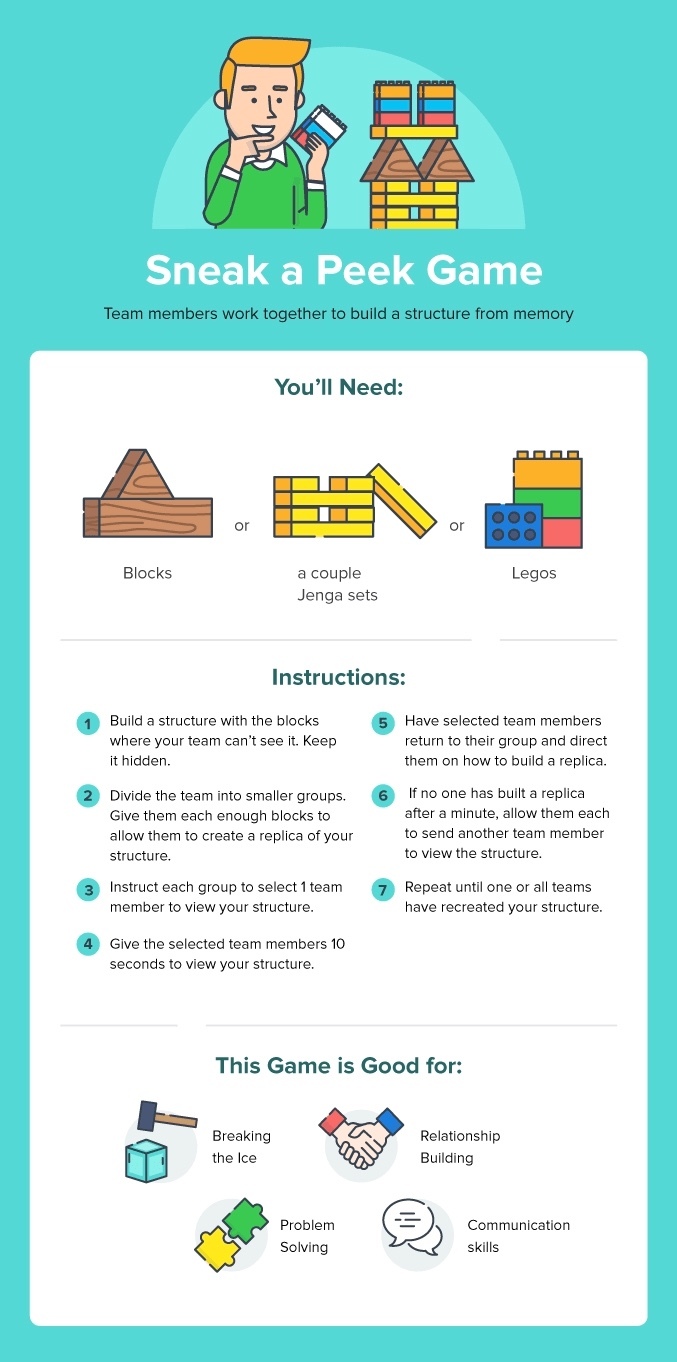
Illustrated Team Building Activities
Download a PDF booklet with all of our illustrated team-building activities. Below you'll find the illustrations with a bit of extra instruction.
Download Now1. Two Truths and a Lie.
Team members give out two truths and one lie about themselves, other team members try to figure out which is the lie.
Instructions:
- Everyone reveals 2-3 things about themselves that are true, and one thing that is a lie.
- The rest of the group tries to figure out which is which and votes to decide which is the lie.
- The person telling the lie gets 1 point for each person they fooled.
- Other players get 1 point for choosing correctly.
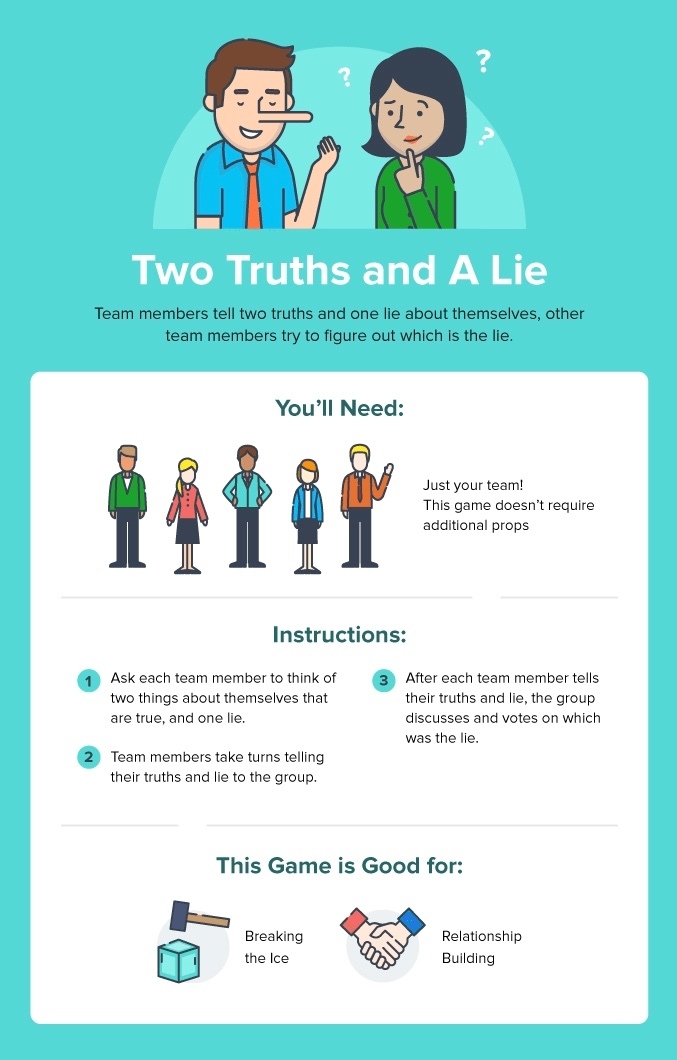
2. Life Highlights Game.
Team members describe the 30 seconds of their lives they would relive if it was their last 30 seconds.
Instructions:
- Each team member spends a few minutes thinking about the best moments of their life.
- They then focus on the 30 seconds they'd want to relive if they were about to die.
- Each team member describes the 30 seconds they chose and why.
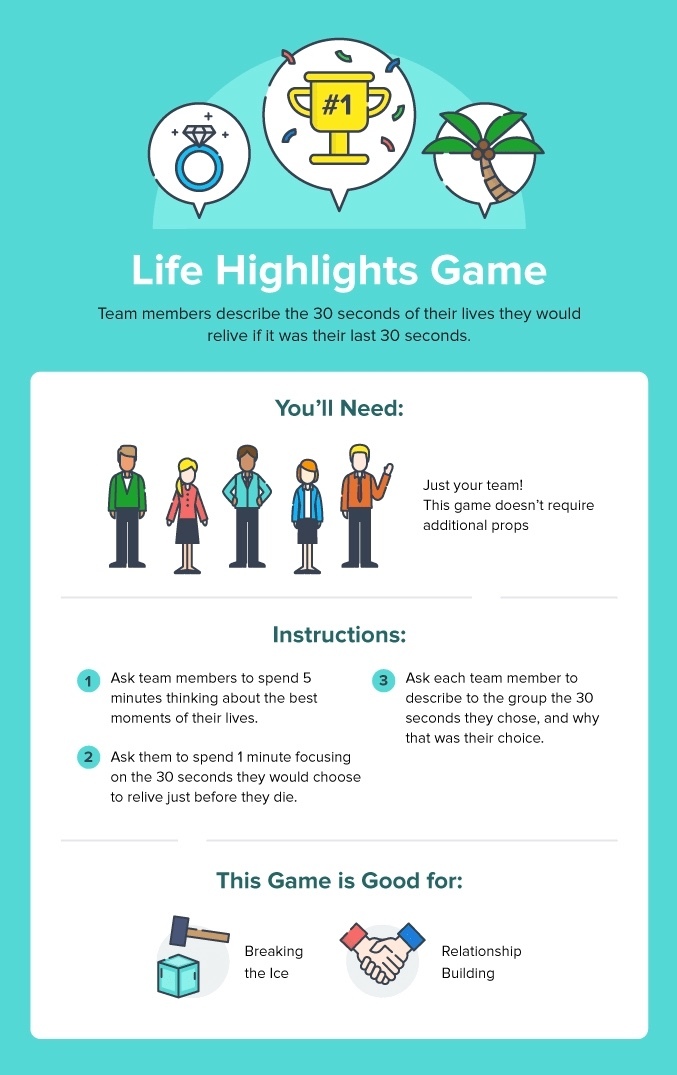
3. The Classification Game.
Team members divide themselves into subgroups based on personal likes and dislikes.
Instructions:
- Teams introduce themselves and talk about personal likes and dislikes.
- Afterward, they divide themselves into subgroups based on their likes and dislikes.
- Two to three subgroups should work for most teams. Try more if it’s a larger group.
- Subgroups should not be negative or discriminatory.
- Example subgroups: coffee lovers, runners, gamers, dog lovers, cat lovers.
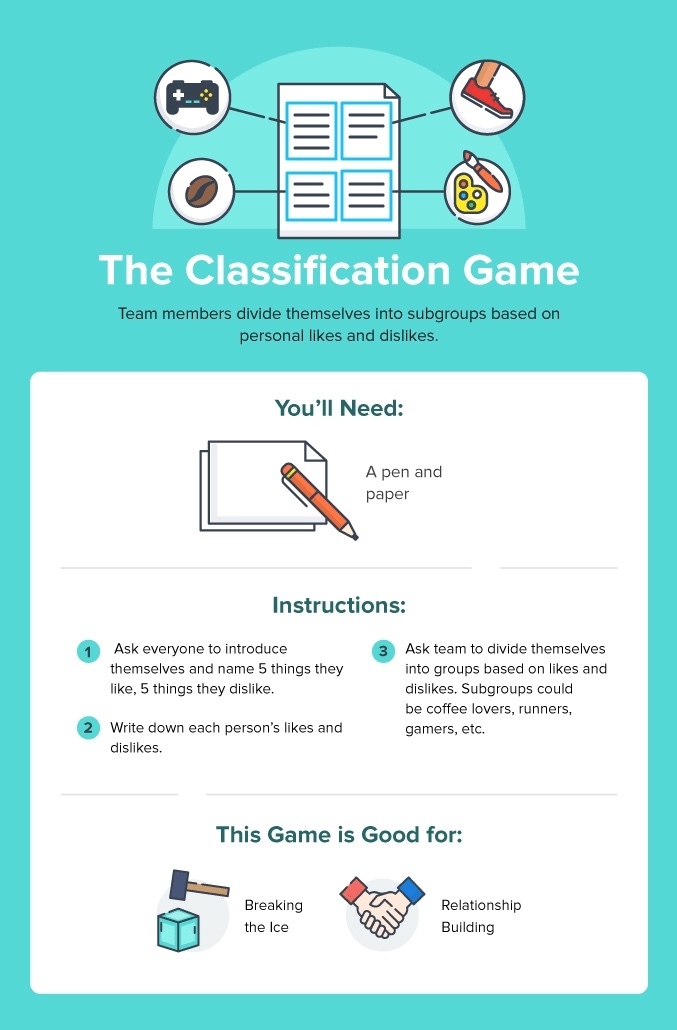
4. Picture Pieces Game.
Each team member draws or paints a piece of a larger, well-known image, without knowing what the “big picture” is. They then work together to assemble the complete image.
Instructions:
- Start with an image of a place, logo, cartoon, or person that everyone will recognize.
- Cut the picture into equal-sized pieces, one for each participant.
- The pieces should have about the same amount of detail in each section.
- Give each participant a piece of the image.
- Ask them to recreate it on a piece of paper or canvas 5, 10, or 20 times larger than the original image.
- The larger the paper or canvas, the longer the exercise will take.
- Supply participants with pencils, pens, markers, colored pencils, etc.
Once each team member is finished, they work together to assemble their individual pieces into a recreation of the original image. The final product can be displayed in the office or workspace.
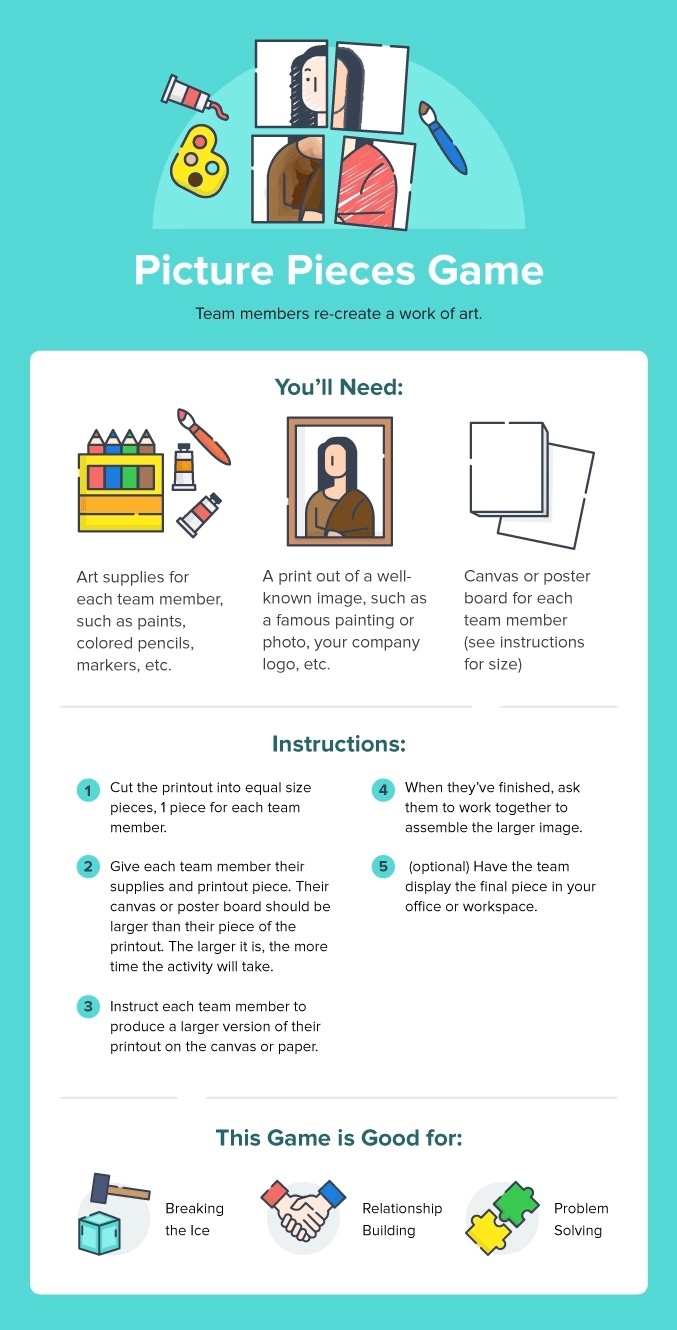
5. Zoom.
Similar to the picture pieces game, but with no drawing or painting skills required. Participants try to put pages of the book Zoom in order.
Instructions:
- Get a copy of Istvan Banyai’s book Zoom.
- Give each participant one image from the book.
- They should not show it to other participants.
- Participants try to get their images into the proper order by explaining them verbally.
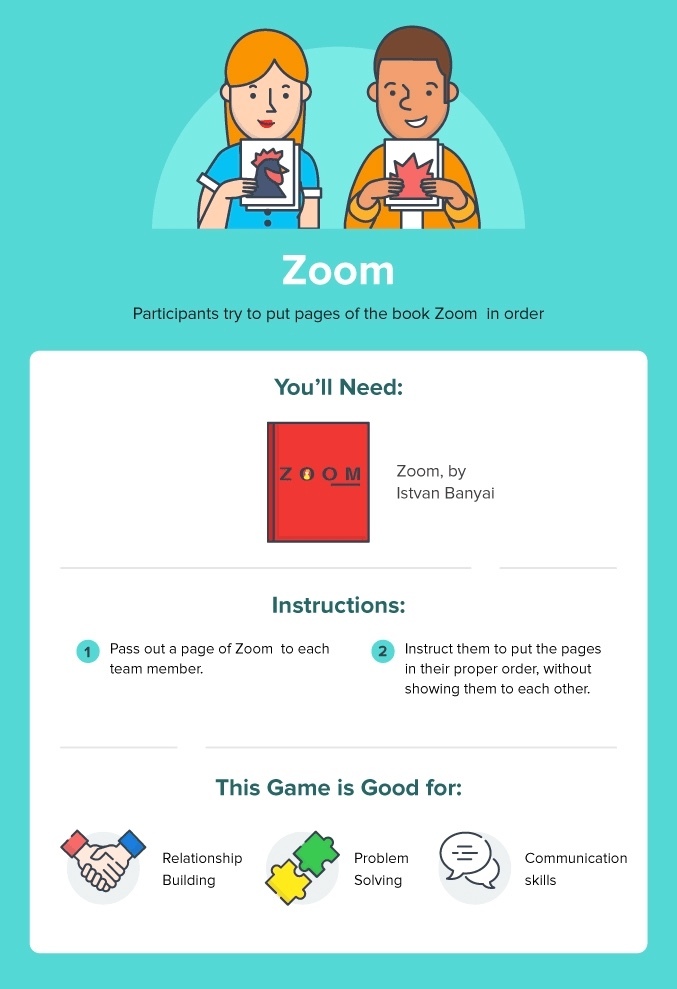
6. Zombie Escape.
Team members solve puzzles to try and escape from one “zombie” team member before they run out of time and space.
Instructions:
- Gather participants in a room, preferably one that is smallish for the group.
- One participant volunteers to be the zombie. Encourage them to be as “zombie-like” as possible.
- In some versions of this game, the “zombie” is tied to something in the room with a rope or chain.
- The chain is given a foot of slack every 5 minutes.
- The rest of the participants try solving a series of puzzles or riddles.
- The goal is to solve the puzzles before the zombie reaches them.
As someone who doesn’t wish to be tied or chained to anything, I suggest marking one-foot boundaries in the room that the zombie’s territory expands into every 5 minutes. This can be done with masking tape, for example.
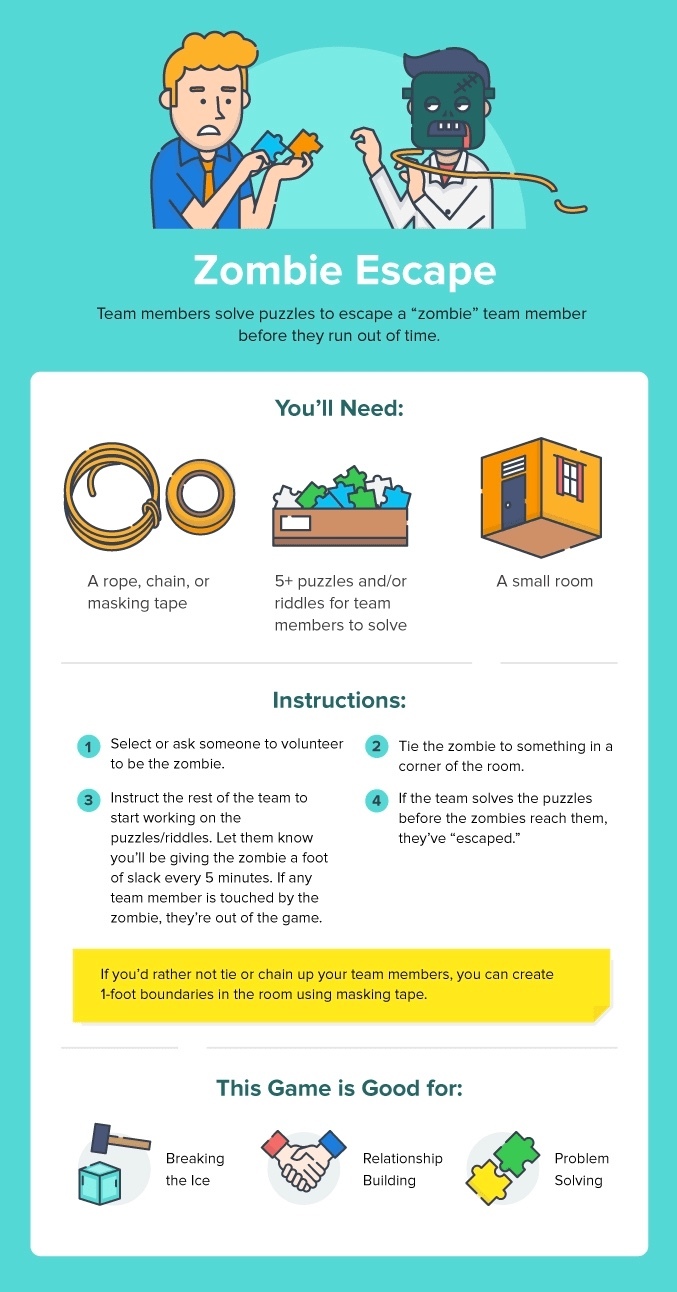
7. Battle of the Airbands.
Teams work to act out/lip-sync the song of their choice.
Instructions:
- Get a music player with loudish speakers and a good music selection.
- A music subscription service like Spotify is probably best.
- Create groups of 3 to 4 people.
- Have them choose a song they would like to lip-sync together.
- Give them some time to rehearse.
- At performance time, bring in independent judges, or let the groups judge the winner.
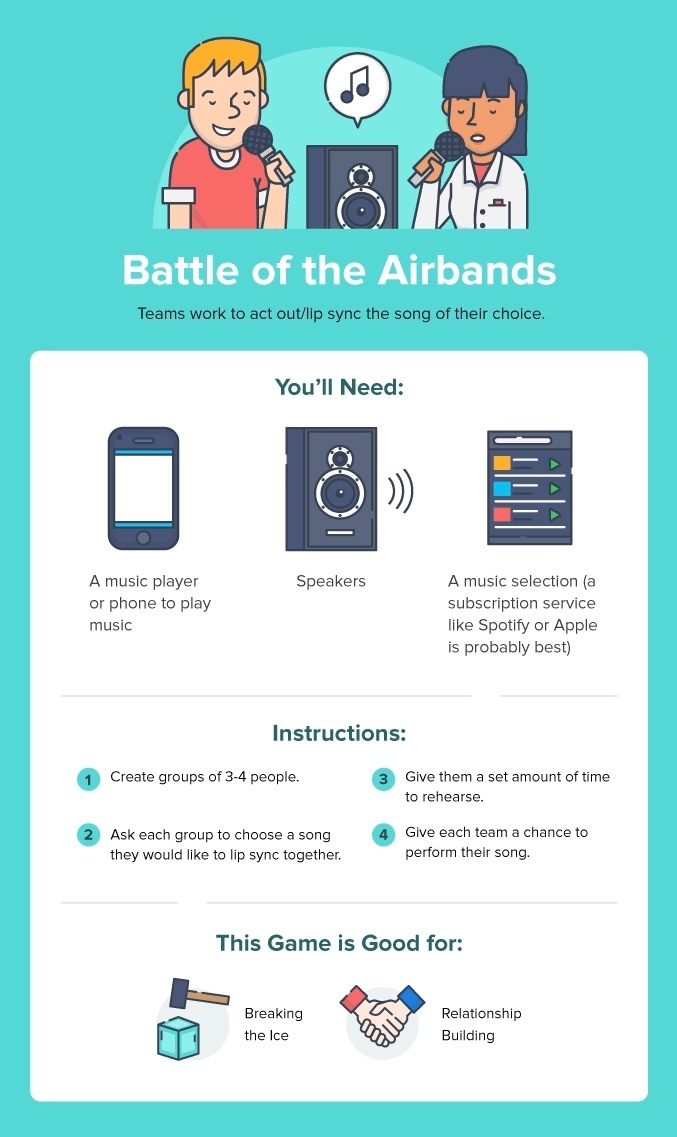
8. Back-to-Back Drawing.
One team member instructs the other on how to draw a replica of a simple image.
Instructions:
- Divide the team into pairs.
- Have each pair sit back to back.
- Give one member of each pair a piece of paper and a pen.
- The other gets a simple image that their partner can’t see.
- Team members with the image describe it to their teammates to help them produce a replica.
- Everyone compares drawings and talks about the difficulties of communicating instructions this way.
- If there's time, repeat the exercise and see how they improve their drawings.
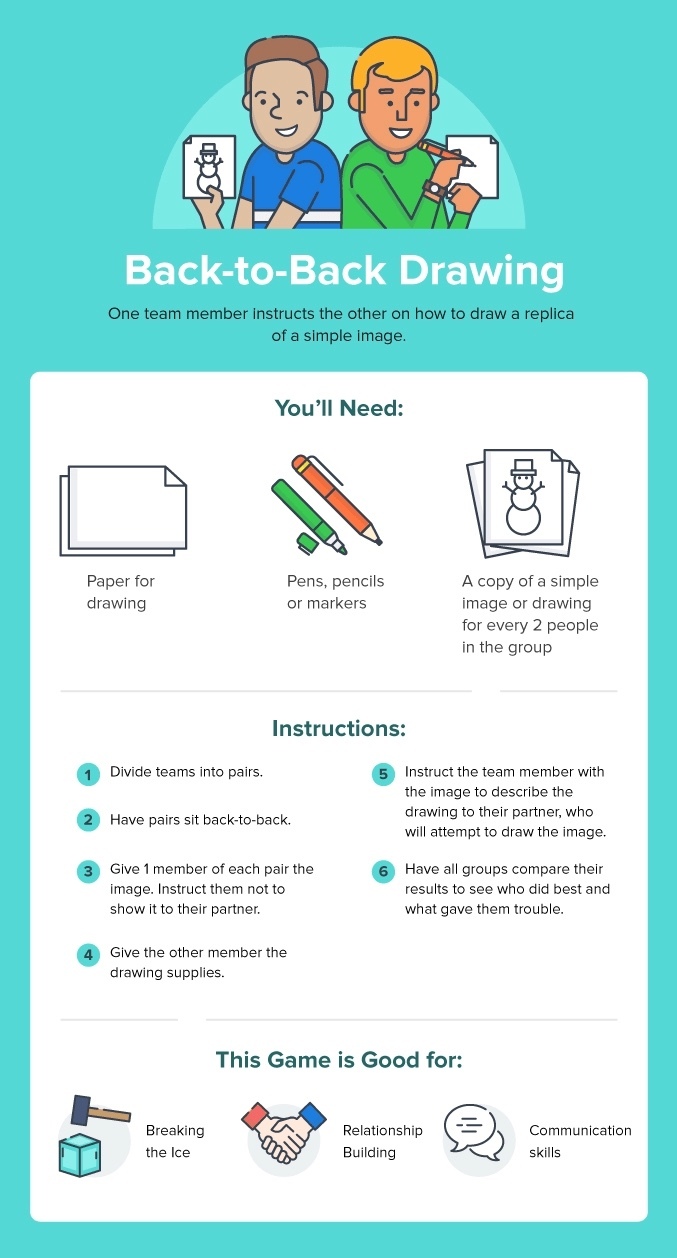
9. Office Trivia.
Team members are quizzed on work-based trivia.
Instructions:
- Create trivia questions about your company or office space.
- Divide the team into smaller groups.
- Groups compete to see who can answer the most questions.
Here are a few examples you can use:
- How many windows does the first floor of our building have?
- What brand of microwave do we have in the kitchen?
- What colors are in our company logo?
- How many chairs are in the conference room?
- What color are the tiles in the entryway?
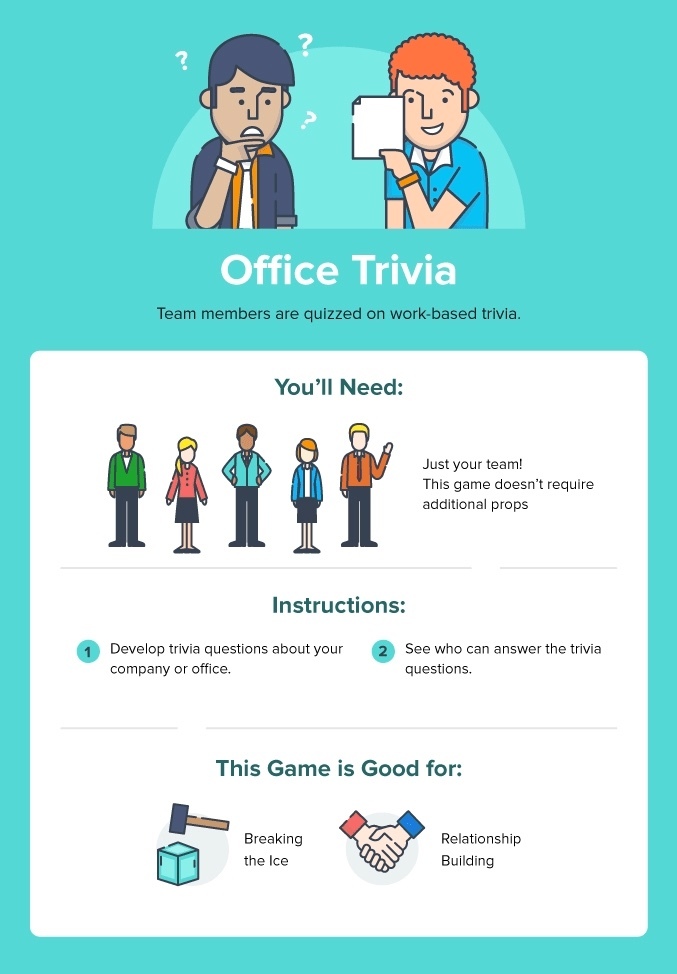
10. Marshmallow Challenge.
Team members use simple materials to try and build the tallest tower they can.
Instructions:
- Divide your team into equal groups.
- Provide 20 sticks of uncooked spaghetti, 1 roll of masking tape, 1 yard of string, and 1 marshmallow.
- Instruct the groups to try and build the tallest free-standing tower they can using the above items.
- Tell them to use as much of the materials as they want, but it must end with the marshmallow at the top.
- Tell them the marshmallow must be whole, but other pieces can be broken up.
- Give a time limit of 15-25 minutes.
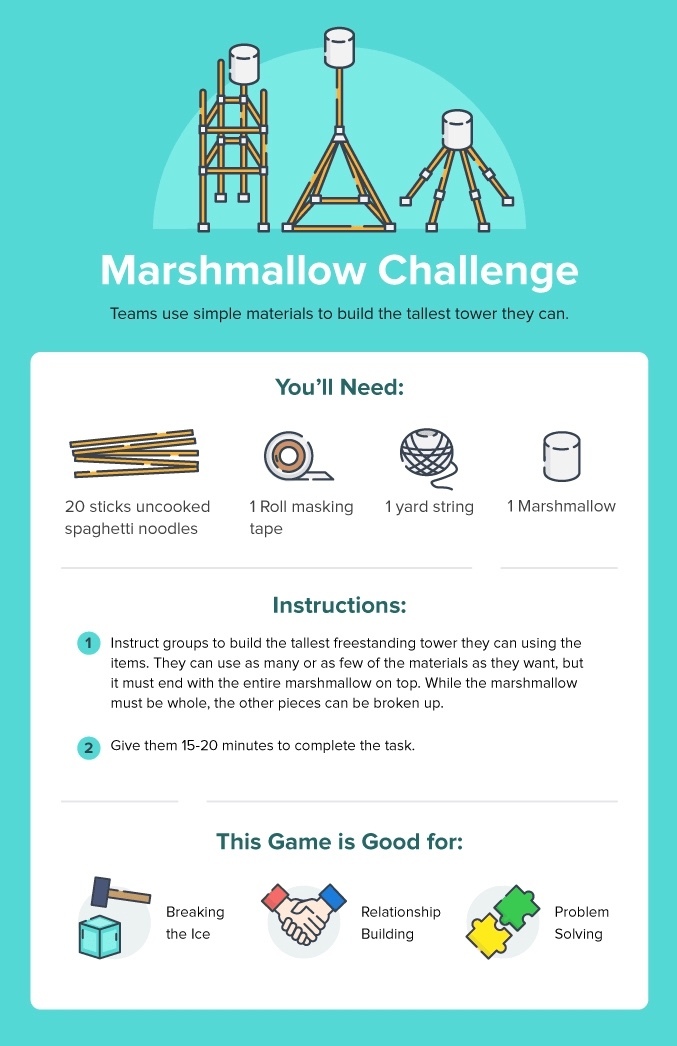
11. Salt and Pepper.
Team members ask questions of each other to try to guess what the secret label is on their back, then have to find their pair.
Instructions:
- Come up with a list of well-known pairs. We've got examples below to get you started.
- Write each one of these on a name tag. So you’d have a name tag with “peanut butter” and another with “jelly."
- Put a tag on each team member’s back so they can’t see it.
- Now, team members ask each other yes or no questions to figure out their label.
- They then have to try to find their pair.
Example Pairs for Salt and Pepper:
- Peanut butter and jelly.
- Mickey and Minnie Mouse.
- Mario and Luigi.
- Salt and pepper.
- Fish and chips.
- Soup and salad.
- Bonnie and Clyde.
- Q-Tip and Phife Dawg.
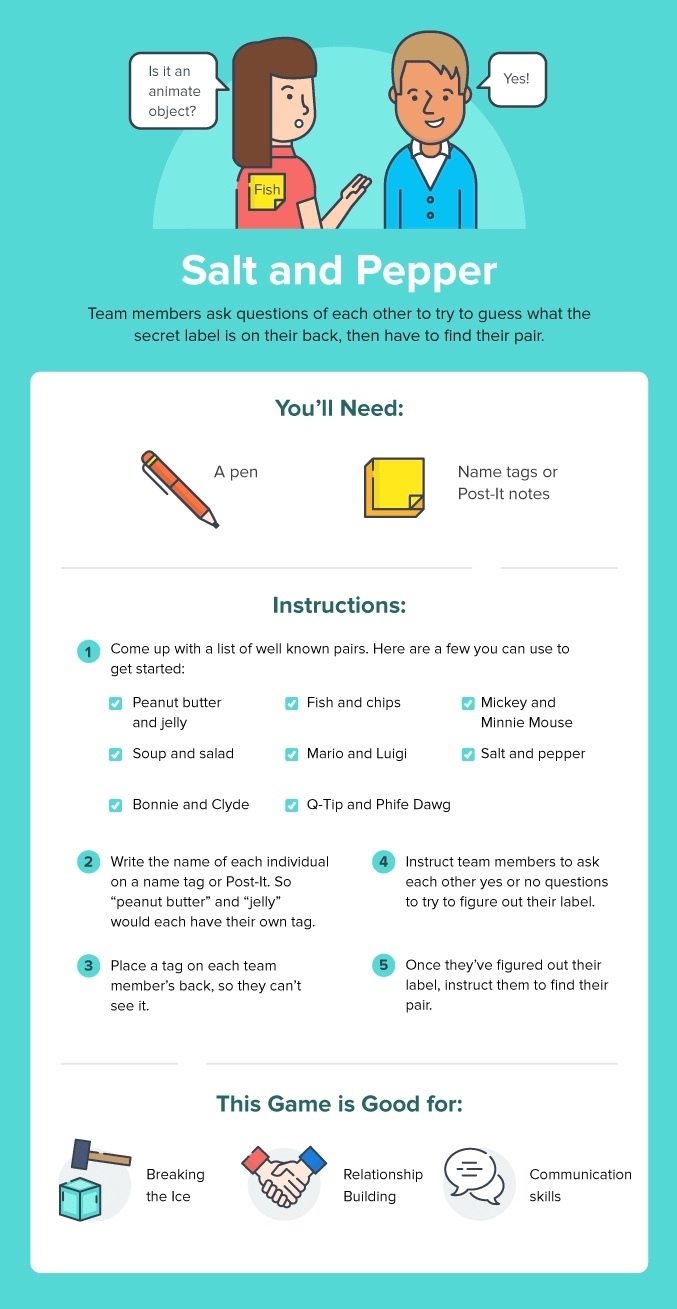
12. Mural Masterpiece.
Team members create artwork that they arrange into a mural.
Instructions:
- Give each team member a canvas and art supplies.
- Give them time to create their own piece of artwork.
- When finished, they'll combine the pieces into a single mural.
- Display the mural in the office or workplace.
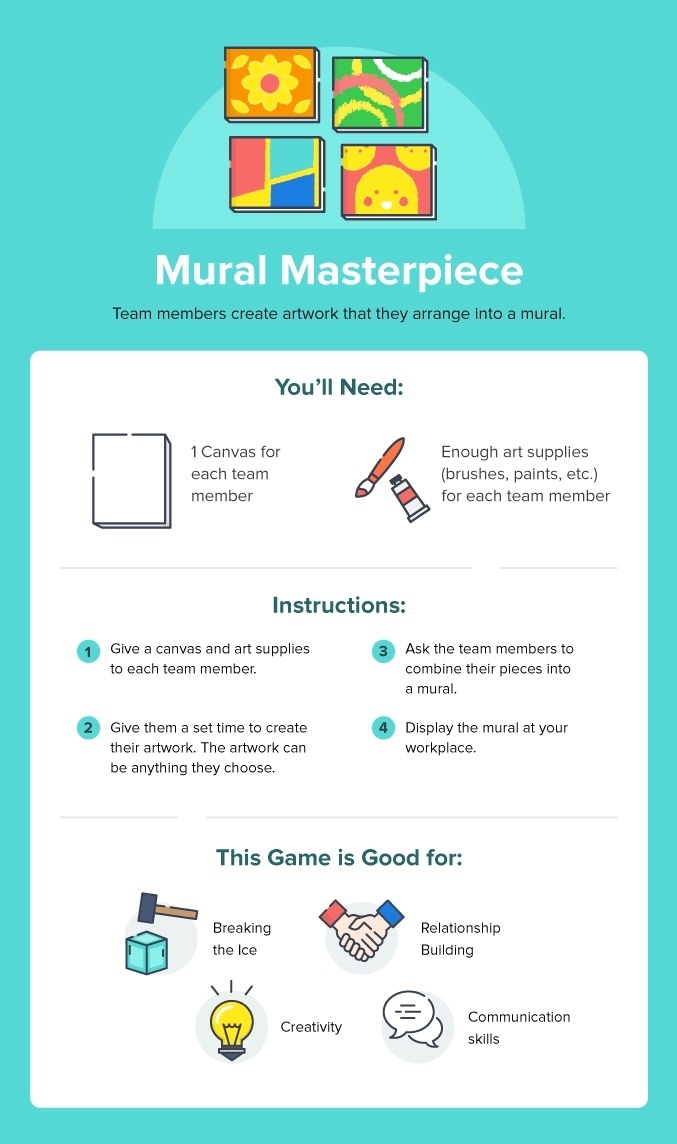
13. Toxic Waste or Bomb Removal.
Team members work together to try and move “toxic waste” safely with a limited set of simple tools.
Instructions:
- Gather 1 small bucket, 1 large bucket, 1 rope, 1 bungee cord loop, 8 bungee cords, 8 tennis balls.
- Use the rope to make an 8-10 foot circle that represents the radiation zone.
- Fill the small bucket with the tennis balls and place it in the center of the circle for your toxic waste.
- Set the large bucket 30 feet from the toxic waste zone.
- Give them a time limit of 15-20 minutes.
- Tell them spilling the bucket results in the “death” of the entire team.
- Tell them dropping individual balls results in the "death" of the nearest player.
- Explain that when the bucket is removed from the radiation zone, players must maintain their distance.
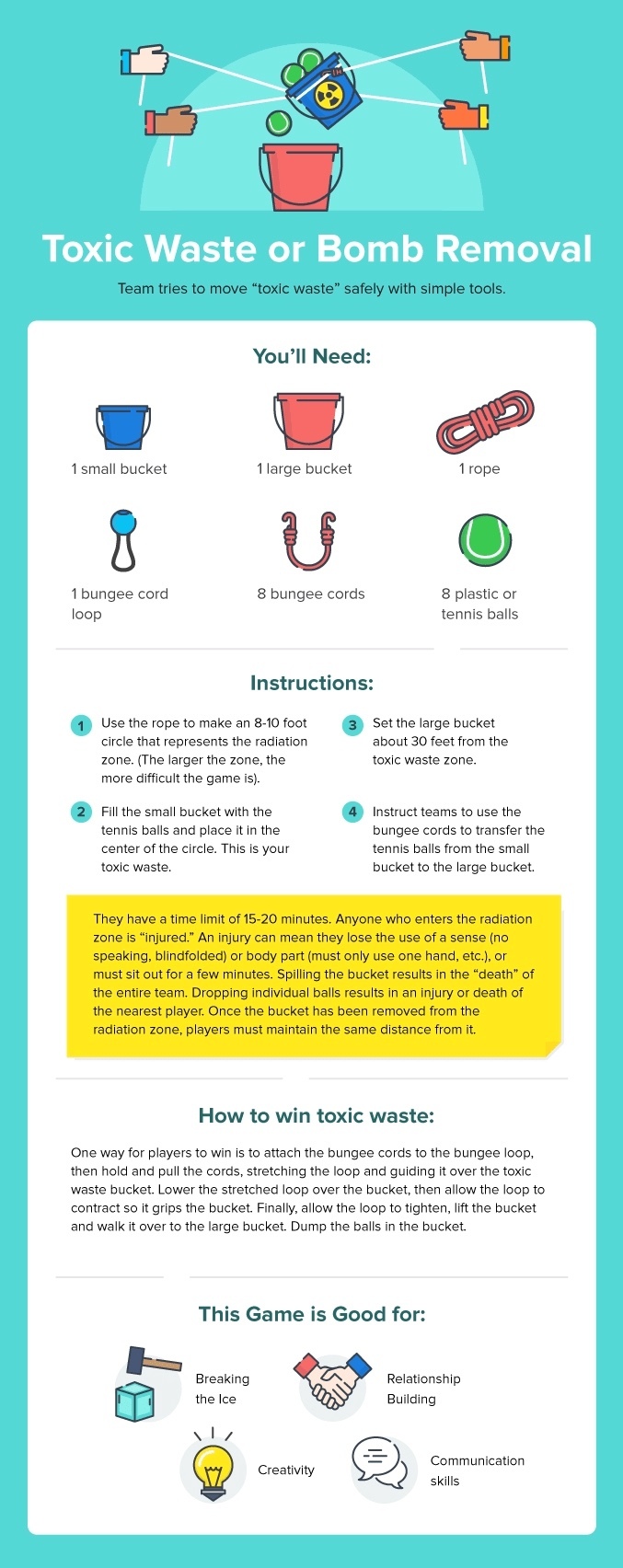
How to win toxic waste:
One way for players to win is to attach the bungee cords to the bungee loop, then hold and pull the cords, stretching the loop and guiding it over the toxic waste bucket. Lower the stretched loop over the bucket, then contract the loop so it grips the bucket. Finally, tighten the loop, lift the bucket, and walk it over to the large bucket. Dump the balls in the bucket.
14. Company Coat of Arms.
Teams create a coat of arms that reflects their perception of the company.
Instructions: Supply your team with paper or canvas and art supplies (markers, colored pencils, etc) to make their company coat of arms.
If you’re unfamiliar, a coat of arms is a shield with symbols on it that represent different aspects of a family, place, or organization. They typically come with a motto as well. Wikipedia has a great entry with an example.
There are a number of different ways to complete the activity once the coat of arms has been created, from hanging it in the office to having teams present their versions of the company coat of arms to each other, and even having different teams try to interpret each other’s coat of arms.
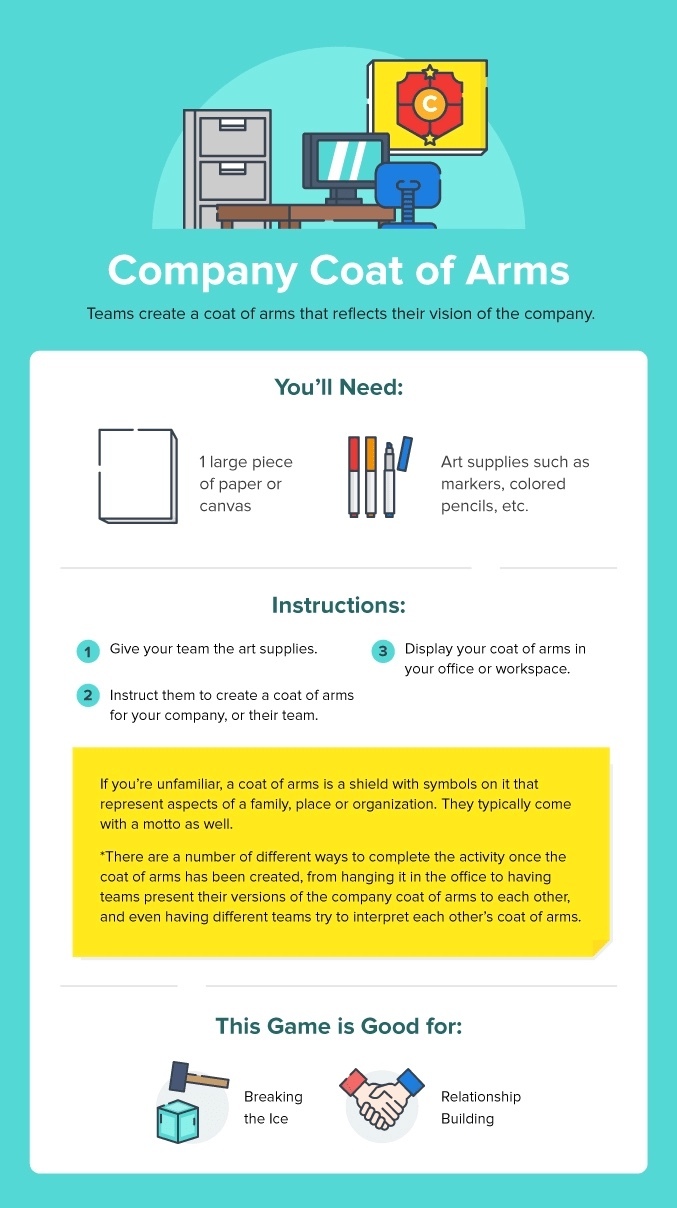
15. Campfire or Memory Wall.
Team members write about, draw a picture, or share a photo of a positive memory from work that matches a topic. The basic idea of this activity is to get employees to share positive memories about the workplace.
Instructions:
Use a whiteboard or sticky notes to present several topics, such as:
- My first day.
- Creativity.
- Teamwork.
- Problem-solving.
- Fun!
- Friends.
- Challenges.
- Accomplishments.
- Goals.
- Allow each participant to choose one topic.
- Have them write about, draw or provide a picture of a positive memory from work that goes with the topic.
- All of these are then displayed together as part of a memory wall.
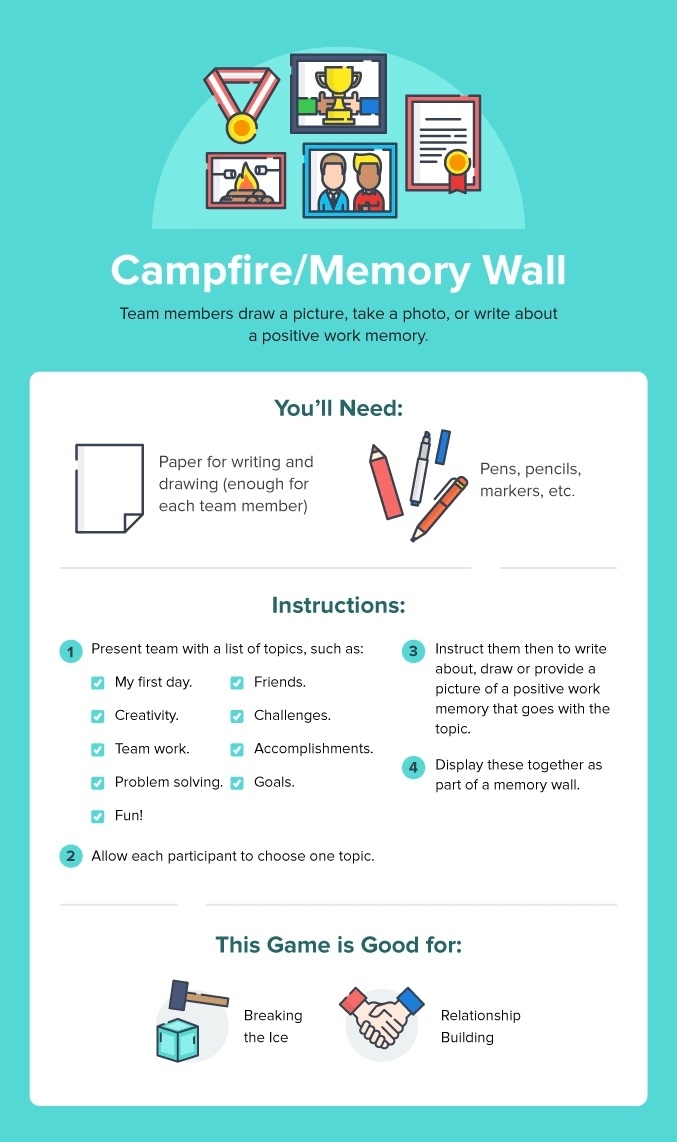
16. Frostbite.
There are several versions of this game. The main variable is which materials the teams are given to build their shelter with. The shelters can be built from small objects, such as pieces of paper, toothpicks, and paper clips, or participants can assemble an actual tent or other pre-fabricated structure.
Instructions:
- Each team chooses a leader.
- The leader has “frostbite” and cannot physically help assemble the shelter. The rest of the team has “snow blindness,” and has been blindfolded. The leader must give instructions to the team so that they can successfully build a shelter without the benefit of sight.
Each team is given their materials for building the shelter and 15-20 minutes.
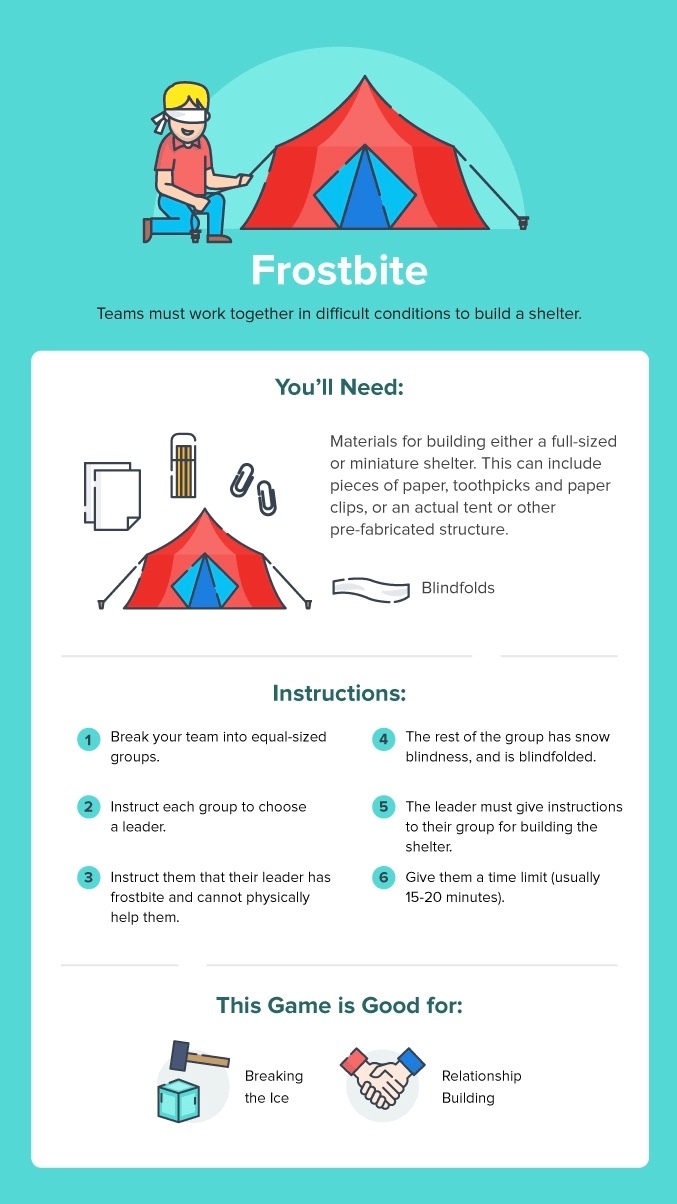
17. Minefield.
Pairs work together to cross a minefield. One member of the team is blindfolded, the other must guide him or her through the minefield.
Instructions:
- Find a large empty space, such as a hallway, conference room or parking lot.
- Create an obstacle course with boxes, folding chairs, garbage cans, etc. These obstacles are the “mines.”
- Divide your team into pairs.
- Blindfold one member of each pair.
- The other pair member guides the blindfolded one through the obstacle course with verbal instructions.
To add more complication, you can allow more than one team on the course at a time.
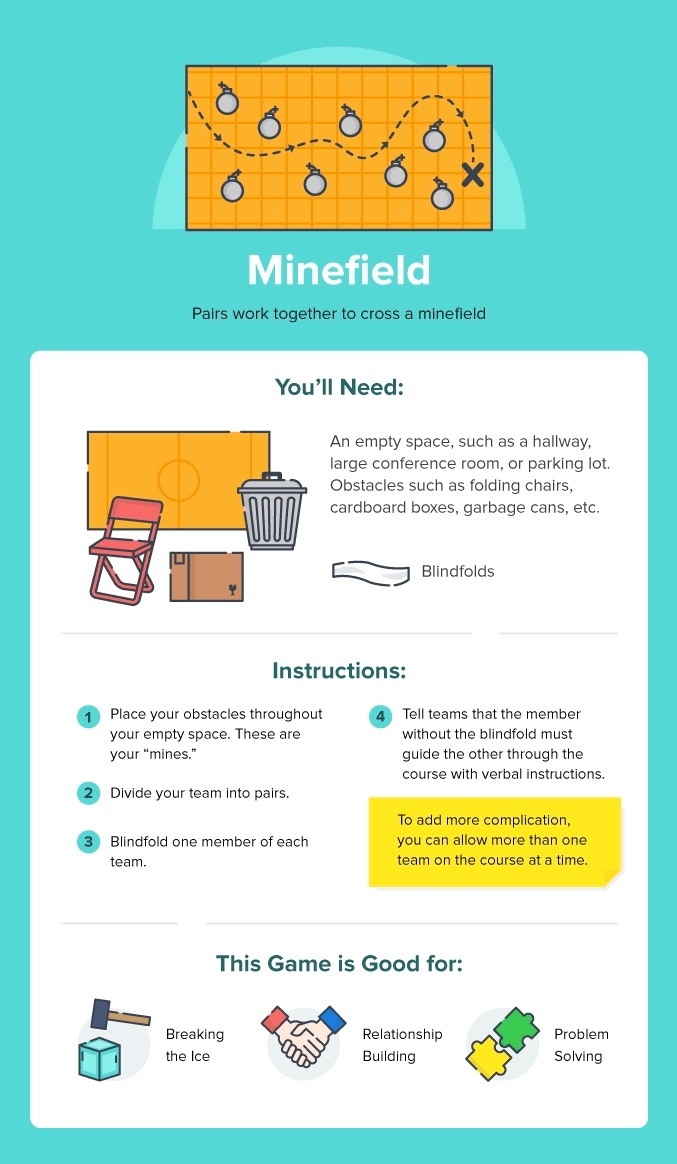
18. Survival.
Teams imagine they are in a survival situation, and rank different objects in order of importance.
Instructions:
- You can use your imagination with this one.
- Team members can be stranded on a desert island, plane-wrecked in the jungle, lost in the Arctic, etc.
- Give them between 7 and 12 items from around the office or workspace.
- Have them rank the items in order of importance for survival.
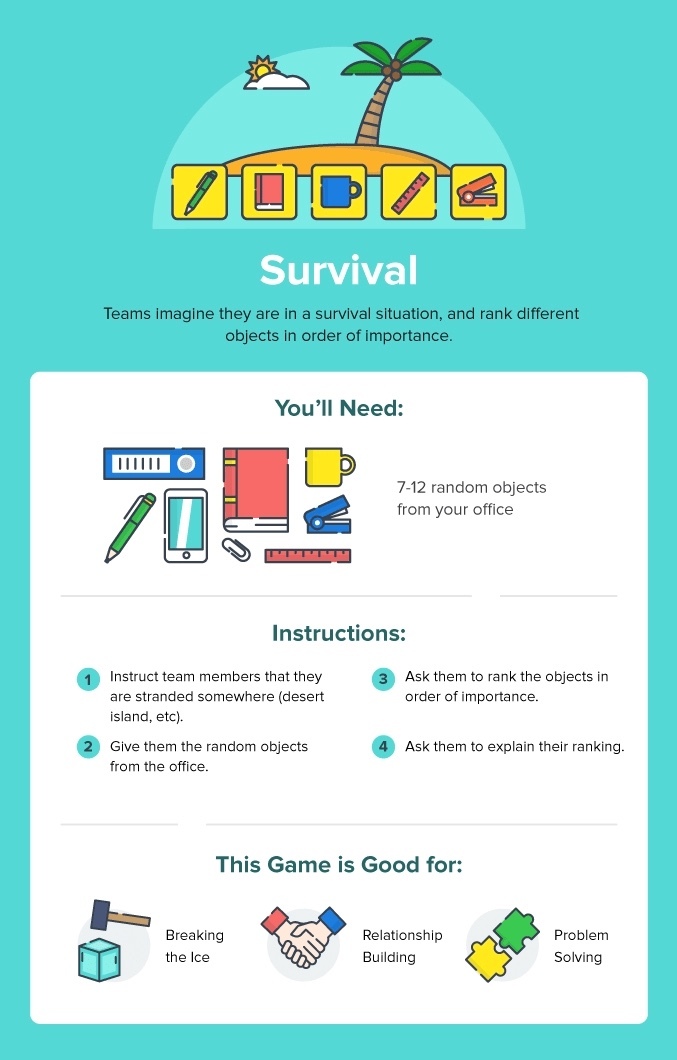
19. Paper Plane Challenge.
Teams build paper airplanes with the goal of building the one that flies farthest or has the longest hang time.
Instructions:
- Find an open space inside or outside.
- Give each team a piece of paper to construct a paper plane within a time limit.
- The winner can be the team that flies their plane furthest or has the longest hang time.
Tips: You can show them a variety of designs, or let them do research online. This latter option is interesting, because there are a lot of designs available, with super complex ones that can take some time to fold and are easier to mess up but promise better flight time. They’ll have to find the balance between performance and complexity.
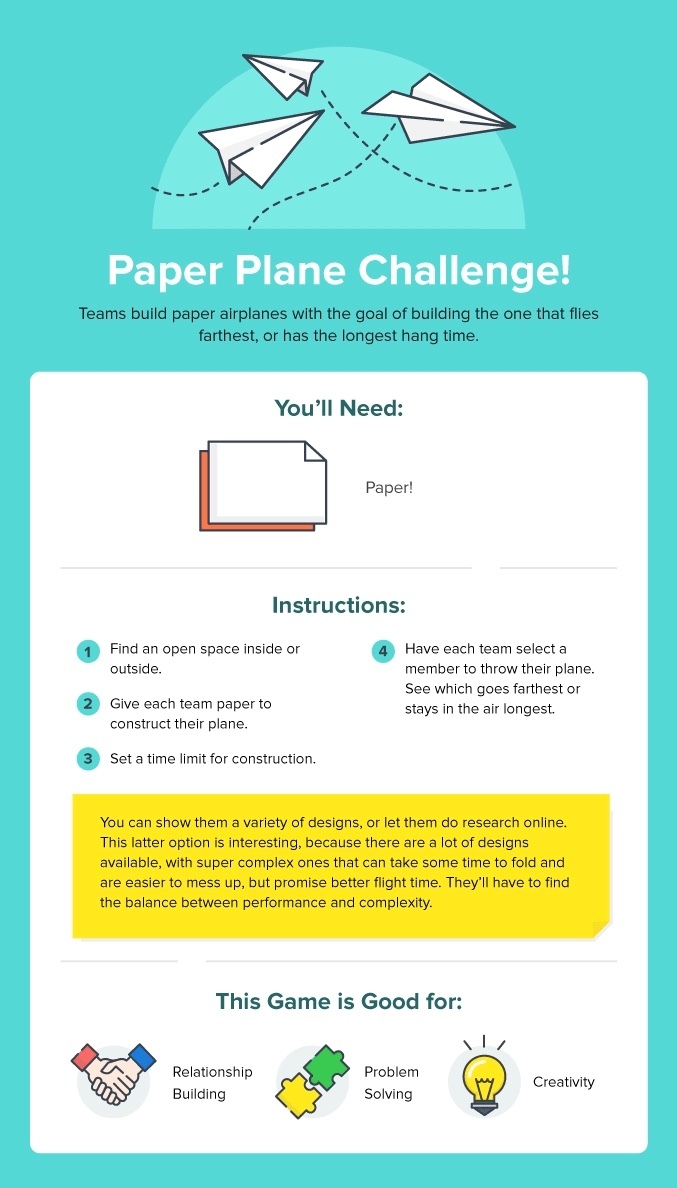
20. Dare Jenga!
Jenga, but with a twist. There’s a dare written on each block. This game isn’t just for college keg parties!
Instructions:
- Take a standard Jenga set and write a dare on each block.
Here are a few dares you can use:
- Sing for 15 seconds.
- Dance for 15 seconds.
- Play next turn with eyes closed.
- Play next turn with feet.
- Tell a joke.
- Spin for 10 seconds before the next turn.
- Keep in mind that you can repeat the dares — you don’t need a new one for each block.
- Stack the blocks as you would for a normal Jenga game.
- When players pull a block out, they have to follow the instructions written on it.
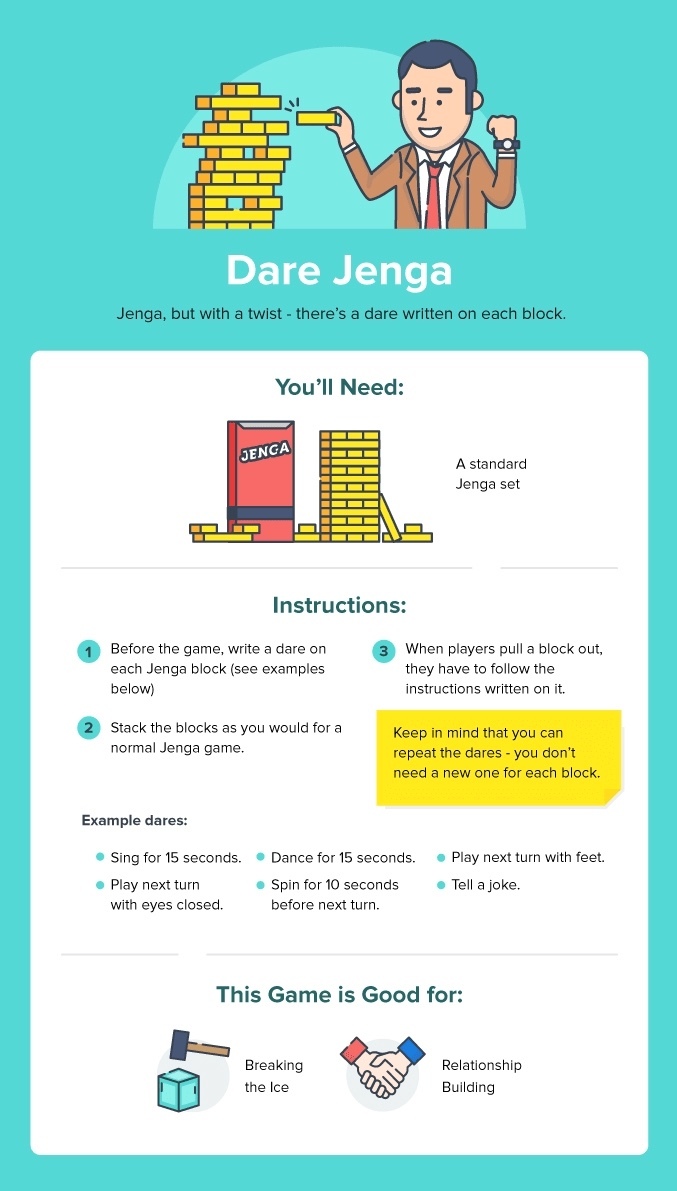
21. Name that Office.
Remote team members try to match photos of remote office spaces to the team member who works there.
Instructions:
- Everyone on the team takes a photo of their remote office space.
- They share it via Dropbox, Google Drive, etc.
- Players try to match that office to the team member.
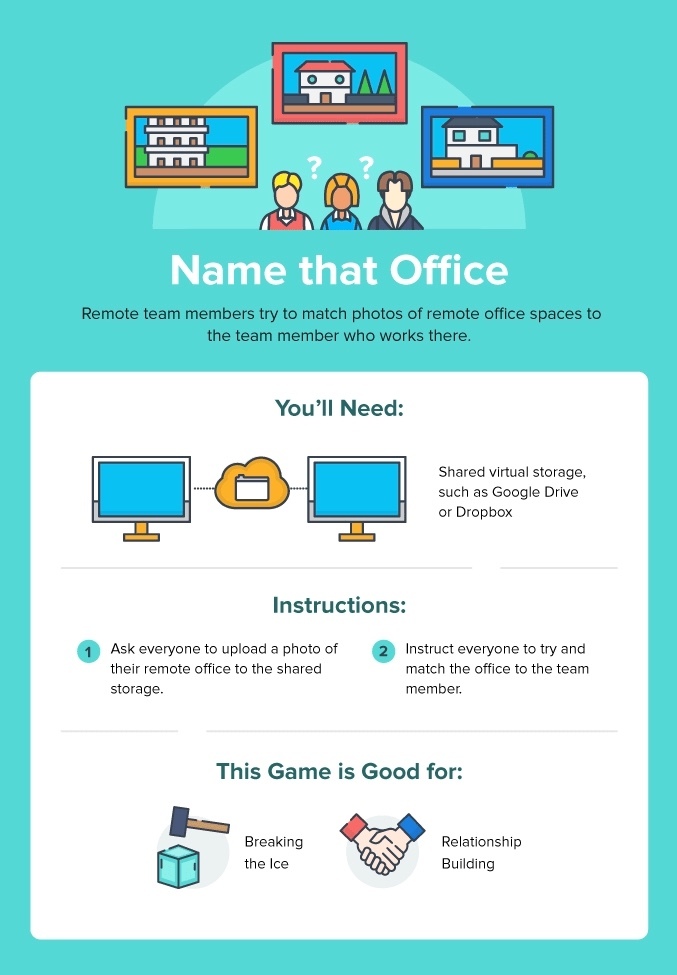
22. The Barter Puzzle.
Teams try to put together mixed up jigsaw puzzles.
Instructions:
- Divide the team into equal groups.
- Each group is going to do a jigsaw puzzle. It’s better if the puzzles require the same skill level, but look very different.
- Remove all the puzzles from their boxes, then redistribute an equal number of pieces from each puzzle into each box. So, if you’re using four 100-piece puzzles, each box will end up containing 25 pieces from each puzzle.
- Give your team very simple instructions, such as, “You have 20 minutes to complete your puzzles” and offer no further guidance.
The teams will have to work together to figure out what happened with their puzzles, and how best to get the pieces distributed correctly. You can add another twist by making it competitive, i.e. the first team to complete their puzzle wins, and see how that changes the game. Alternatively, you can give them all pieces of the same puzzle. The teams will have to figure out that they’re all working on the same puzzle and come together to solve it.
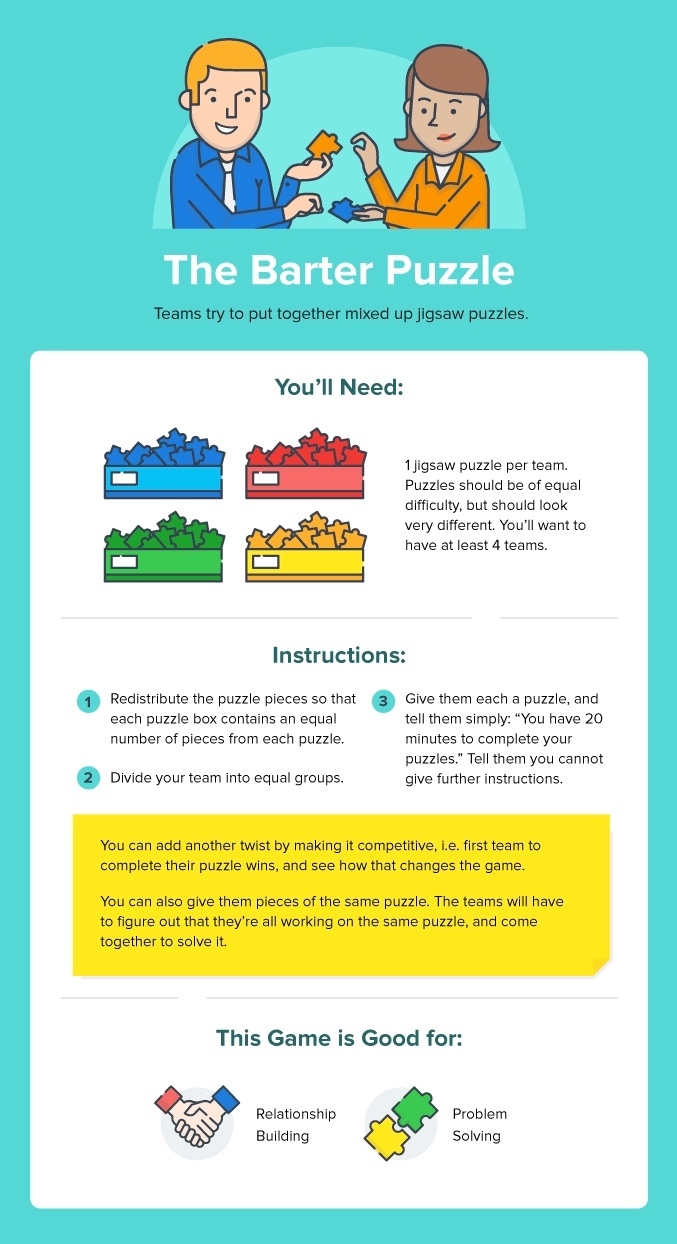
23. The Team Journal.
The team or company works together to create a shared journal.
Instructions:
- Buy a blank notebook or a journal, along with pens, pencils, and other art supplies.
- Put the journal and supplies in a common area and invite employees to contribute to it.
- Preferably you can trust people to be adults and not put anything offensive or inappropriate in the journal.
Tip: I almost think that if you need to create rules, then the journal isn’t for your company… That said, some companies do put basic rules/guidelines in the journal.
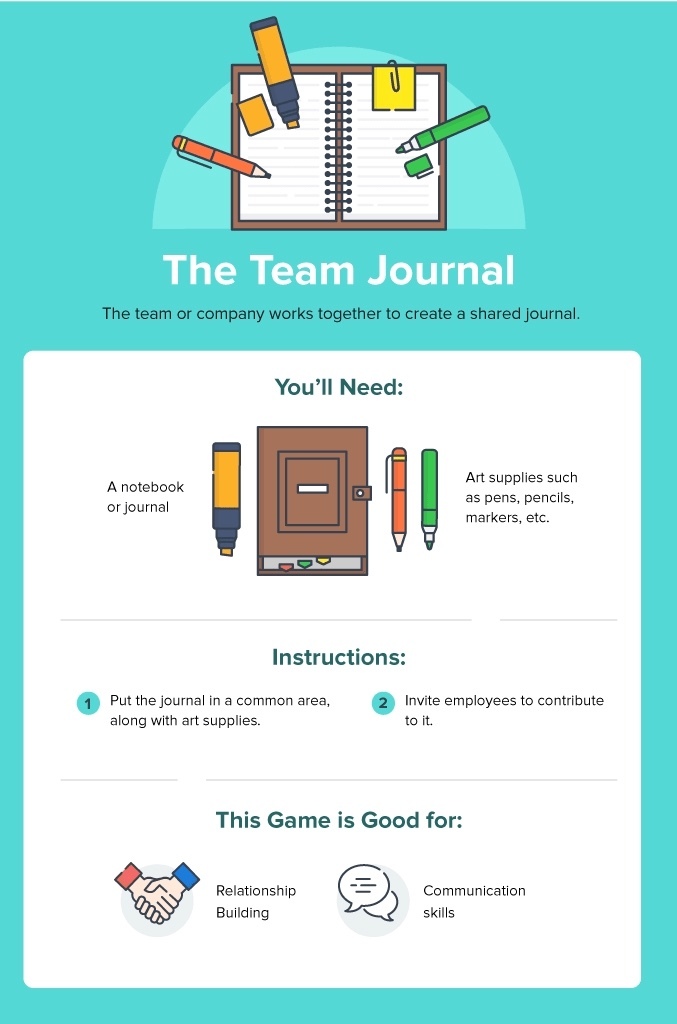
24. Scavenger Hunt.
Teams compete to see who can find all of the items on a list.
Instructions:
- Create equal-sized groups to compete against each other.
- Give each team a list of things to find.
The winner can be the first team to find all the items, or the team that finds the most items in the allotted time (if you need to speed it up). You can give the teams a straight list of items to find, or you can give them clues about what items they have to find.
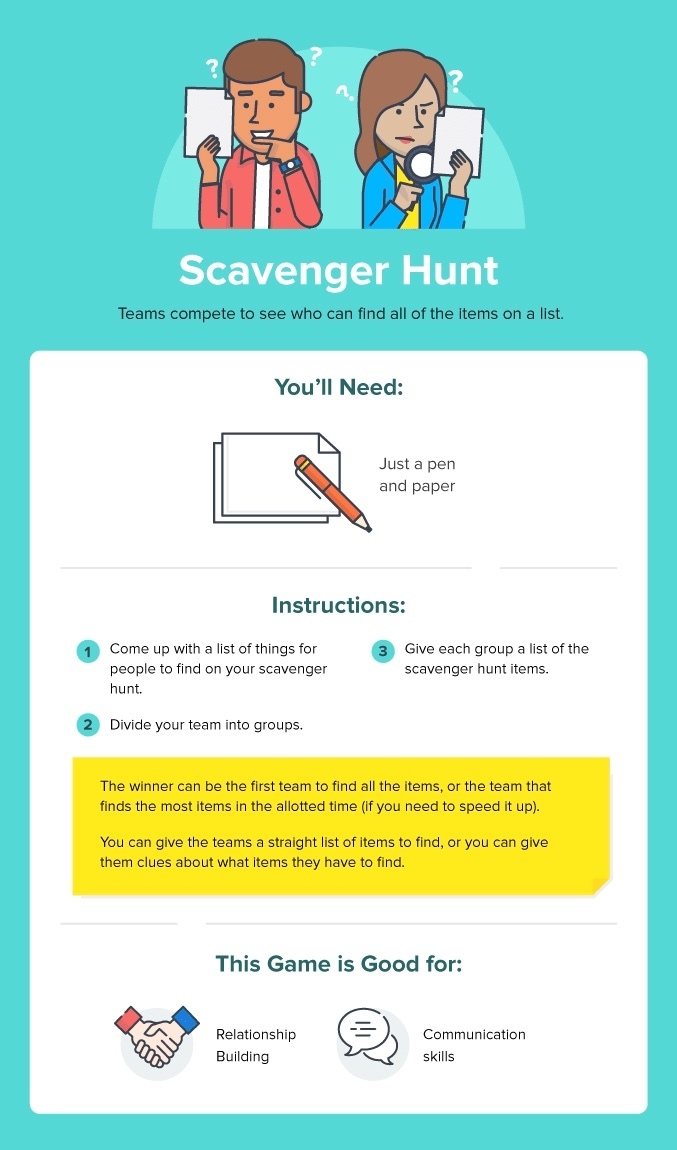
25. Show and Tell.
It’s likely that you haven’t done this one in a while. Everyone gets to bring an item from home and explain it to their team.
Instructions:
- Participants bring an item from home and present it to the rest of the group.
- That’s it. You may want to set a 15-minute timer.
Tips: You could have everyone bring in show and tell items on a single day, but that would get long, and probably boring. You’ll probably want to pick a day of the week that is always show and tell day, and have everyone sign up for a date.
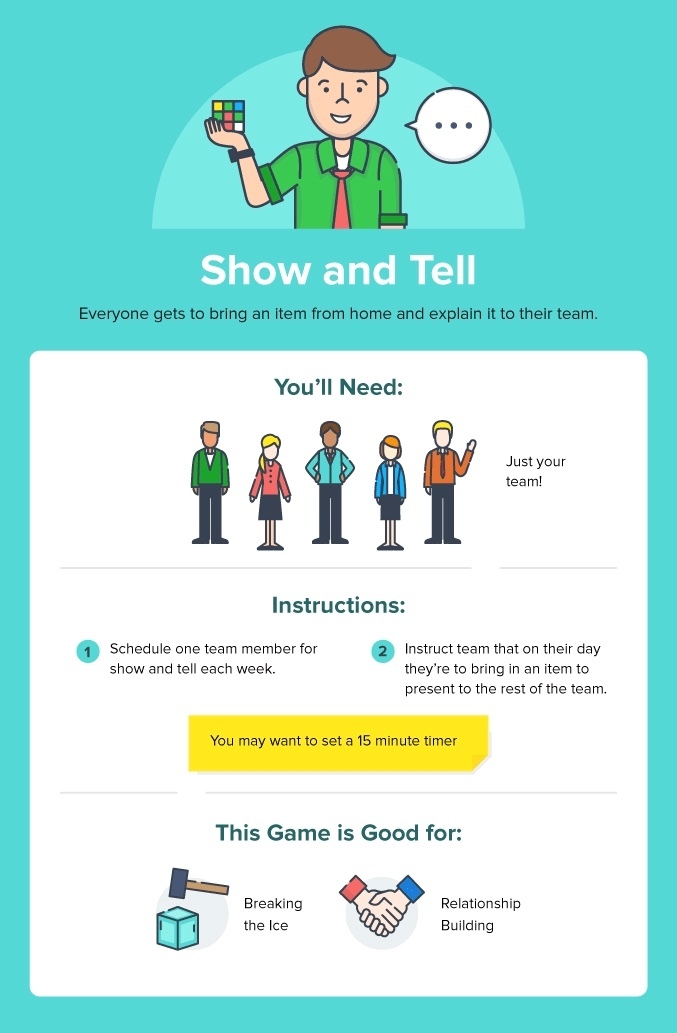
26. Mad Lib Mission Statement.
Ever play Mad Lib? Basically, you complete sentences with random words, then read the story out loud. The results are usually bizarre and funny. In this version, you apply the game to your company mission statement.
Instructions:
- Remove key parts of speech, such as nouns, verbs, adjectives, and adverbs from your mission statement.
- If it’s been a while since you’ve had an English class, review these definitions for part of speech.
Make a copy of the mission statement with blanks for the removed words.
There are a number of ways to play from here. One fun version is to have everyone supply words based on the parts of speech needed, and then read the mission statement with the words they provided.
Then, when they know it’s for the mission statement, you can have them do different versions — the funniest one they can think of, the most ideal, the most honest, etc.
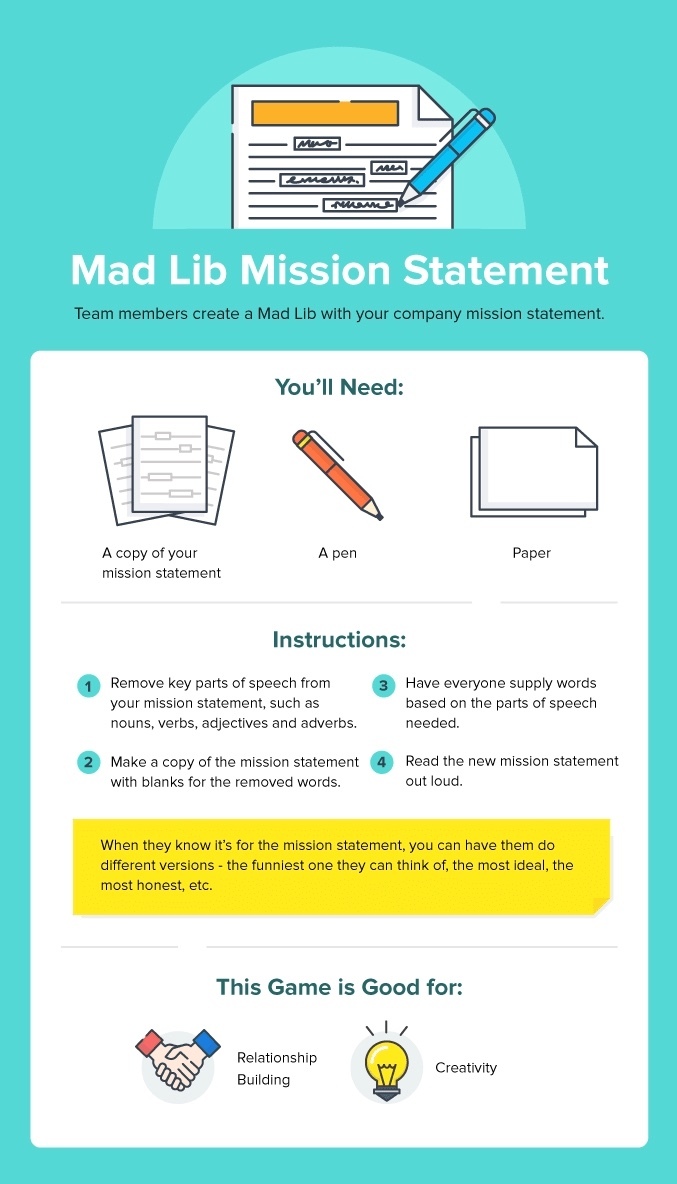
27. The Perfect Square.
The team works together to take a piece of rope from a circle shape to a square shape, while blindfolded.
Instructions:
- Have the team sit in a circle.
- Each team member should then be blindfolded.
- Take a piece of rope long enough to stretch the length of the circle and tie the ends together.
- Give each team member a piece of the rope to hold, and instruct them to form a square out of it.
In some variations, team members come up with a plan first, then put on their blindfolds and are not allowed to speak while forming the square.
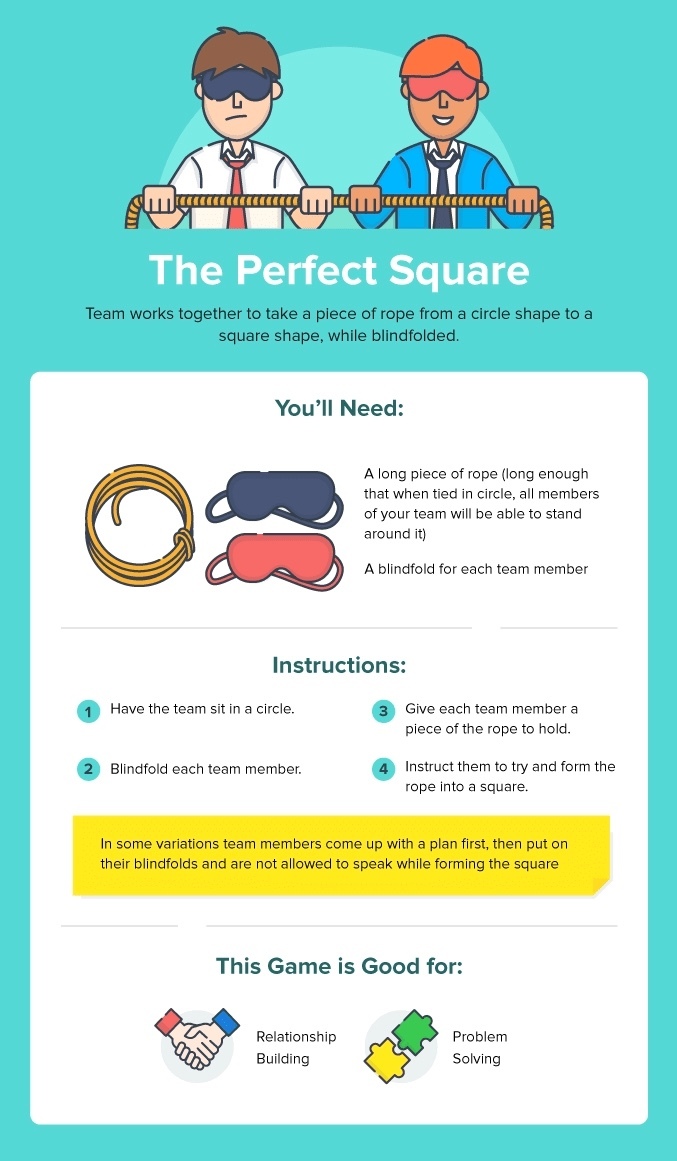
28. What's My Name?
This game is similar to Salt and Pepper but uses famous people or common types.
Instructions:
- Use name tags or other labels to write down the name of someone famous or of a type of person (explorer, inventor, astronaut, professional athlete, etc).
- Attach the name tags to the backs of team members, so they cannot see them but everyone else can.
- Allow the group to mingle and ask each other questions.
- When a team member figures out who they are, they can exit the game.
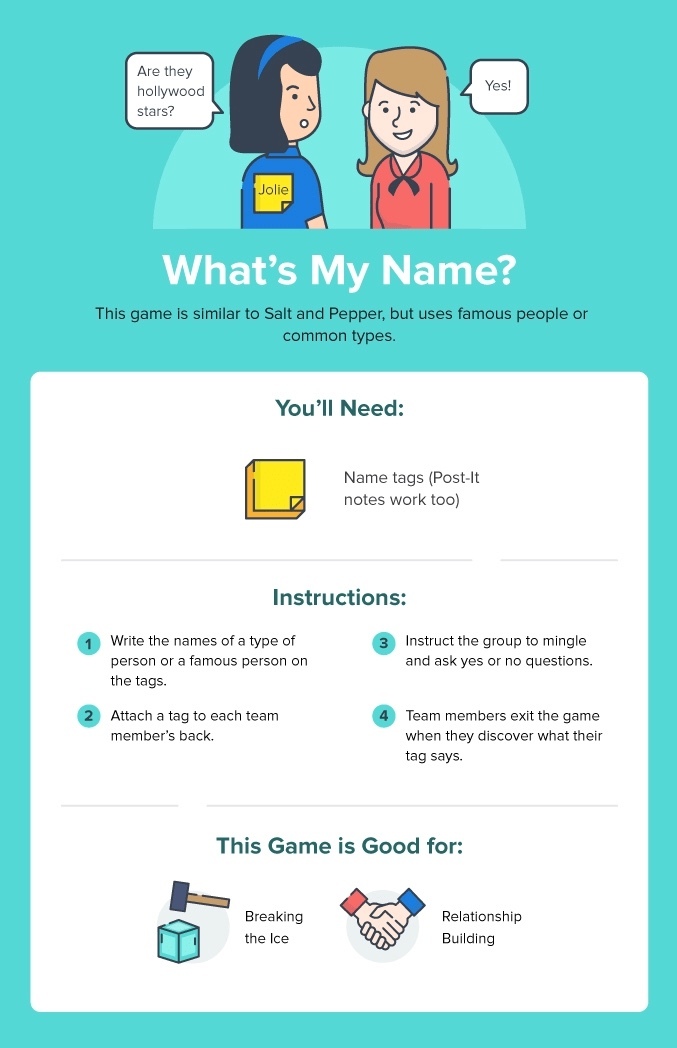
29. Team Timeline.
The team creates a timeline that combines important moments for the company with important moments in their life.
Instructions:
- On a roll of butcher paper, create a timeline that starts when the company was founded, or when the oldest member of your team was born.
- Mark years on the timeline, and, with the help of your team, note important dates for the company.
- Now ask team members to add 3-5 important events from their lives to the timeline.
You may also choose to have them add important local and world events.
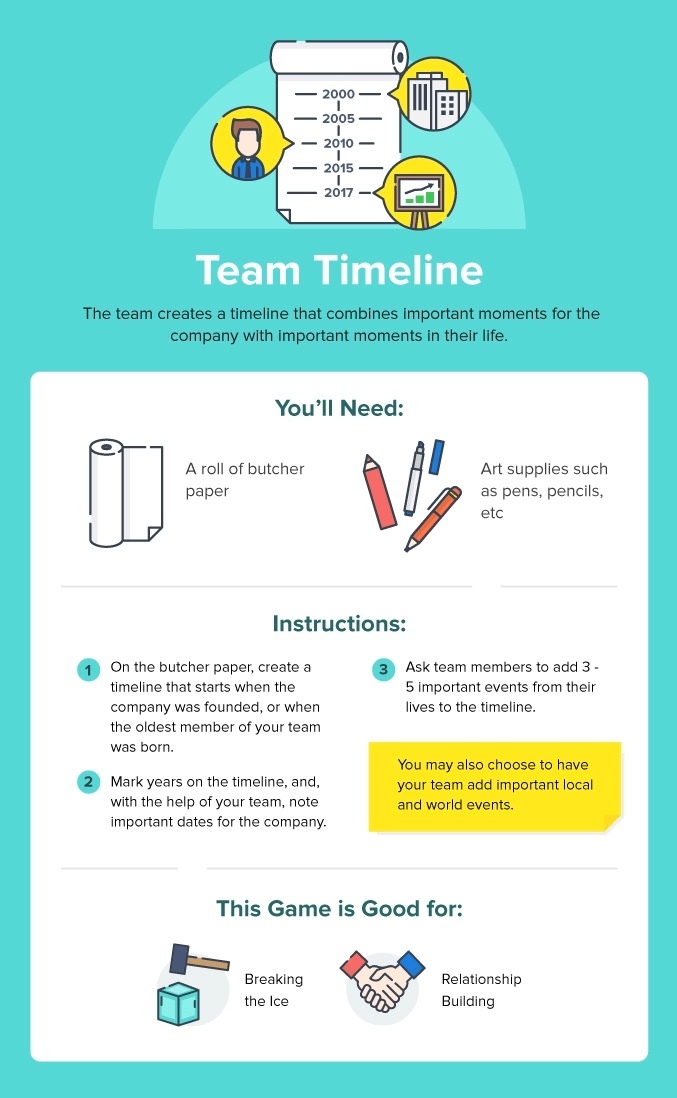
30. What's on Your Desk?
Teams turn an item from their desk into a product that they develop.
Instructions:
- Ask each team member to get one item from their desk. It’s usually best if you don’t tell them why.
- Divide the teams into equal-sized groups, and have them choose one desk item that is going to be their “product.”
- Give them a time limit of about 2 minutes to decide.
- They will name the product, create a logo, and come up with a marketing plan within a time limit.
- Once the time is up, each group will present their product.
- They can then talk about the pros and cons of each product and marketing plan, and brainstorm ideas for improving them.
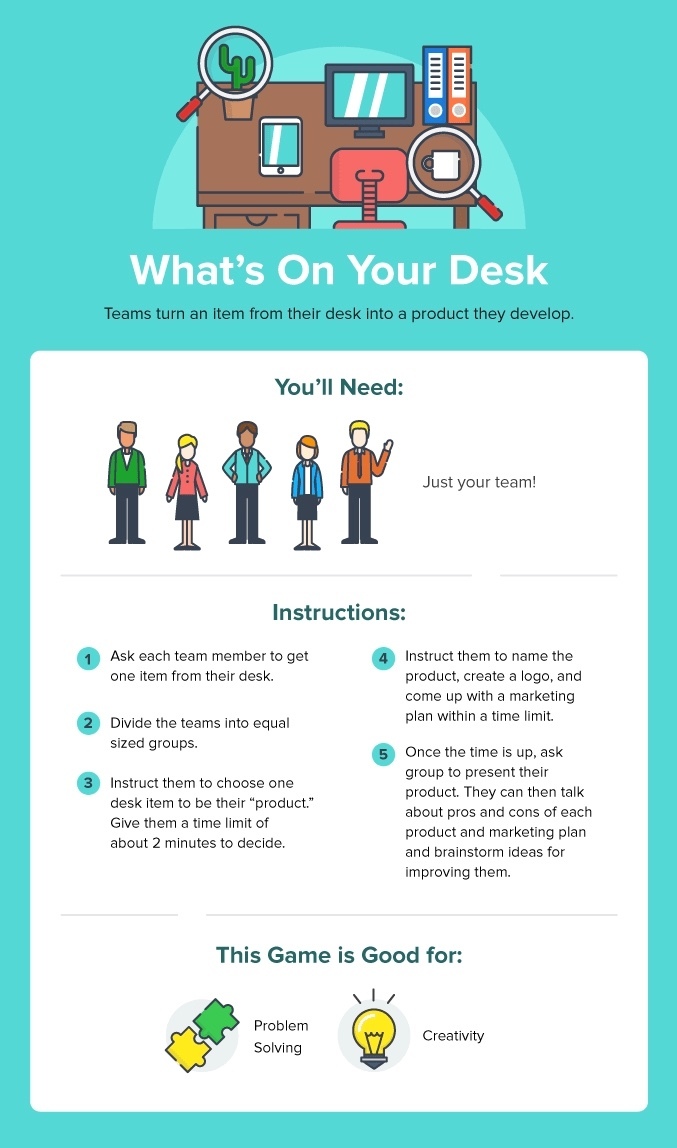
31. Classify This.
Teams try to group random objects into categories.
Instructions:
- Gather a group of 20-25 objects that are, at first glance, unrelated.
- Split your team into smaller groups.
- Ask each to classify the objects into four groups within a set amount of time.
- Afterward, have each group present their list, and how they came up with each grouping.
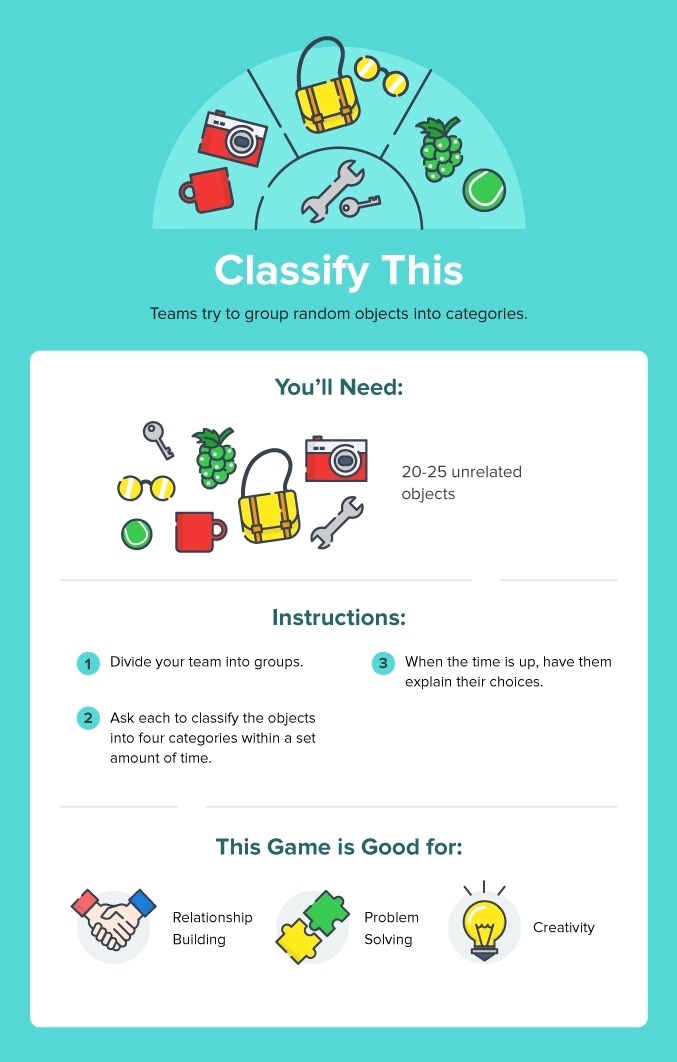
32. This is Better Than That.
This game is similar to survival. Teams try to organize objects by usefulness based on an imaginary scenario.
Instructions:
- Divide your team into smaller groups
- Give them a survival scenario, such as: you’re trapped on a desert island, your plane has crashed in the jungle, the zombie apocalypse has started.
- Give them four objects that have no obvious utility in this situation.
- Ask them to rank the objects in order of usefulness, within a set time limit.
- When the time is up, have them explain their choices.
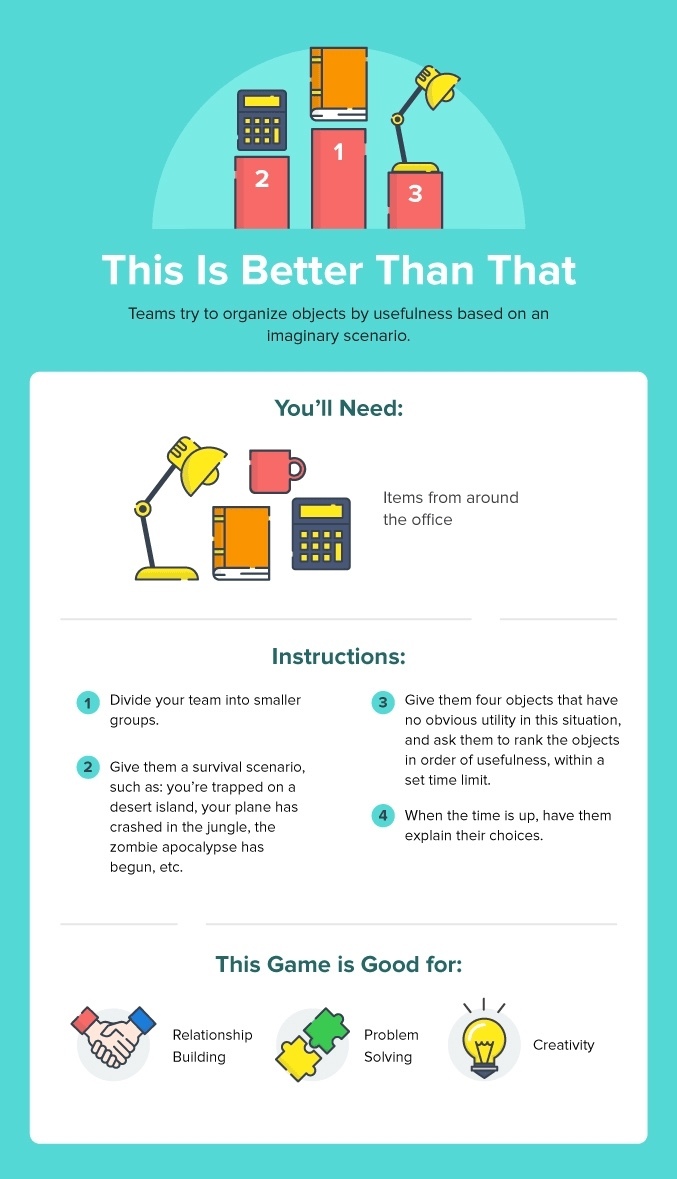
33. The Meta Team Building Exercise.
The object of this post-modern team building activity is to create a new team building activity.
Instructions:
- Talk about what team-building activities they’ve done, which were best and worst, what they love about them, and what they absolutely hate.
- Ask them what they think the purpose or purposes of a team-building activity should be. To improve problem-solving skills? Creativity? To promote bonding?
- Now give them a time limit to come up with their own team-building activity.
- Once the time is up, have them do the team building activity.
If they enjoy it, they can continue working on ideas for refining it and do the activity on a monthly or weekly basis. Ideally, the team develops its own team building activity that it enjoys.
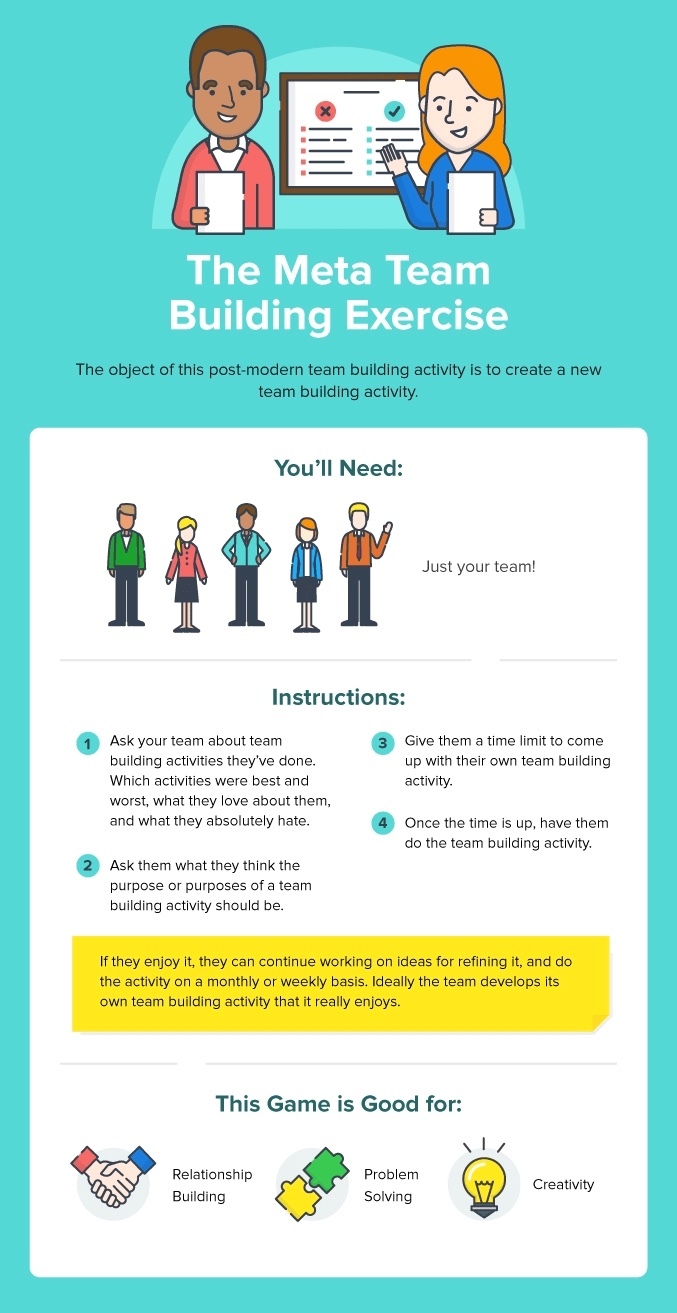
34. Company Memory.
Similar to the game Memory that most of us played as children, only instead of trying to remember pictures of animals, etc. you’ll be using things related to your company.
Instructions:
- Create a deck of memory cards related to your company.
- You can create these for the team, or have the team create them as part of the game.
- The cards can consist of words, drawings, or photos of things related to the company, such as:
- Names or pictures of products.
- Names or pictures of individual team members.
- Names or pictures of different locations associated with the company.
- You’ll want at least 16 cards to start.
- Lay each of the cards out randomly, face down. The more cards, the more difficult.
- Each player gets the opportunity to flip over two cards per turn.
- The object is to flip over two of the same card by remembering where the matching card is.
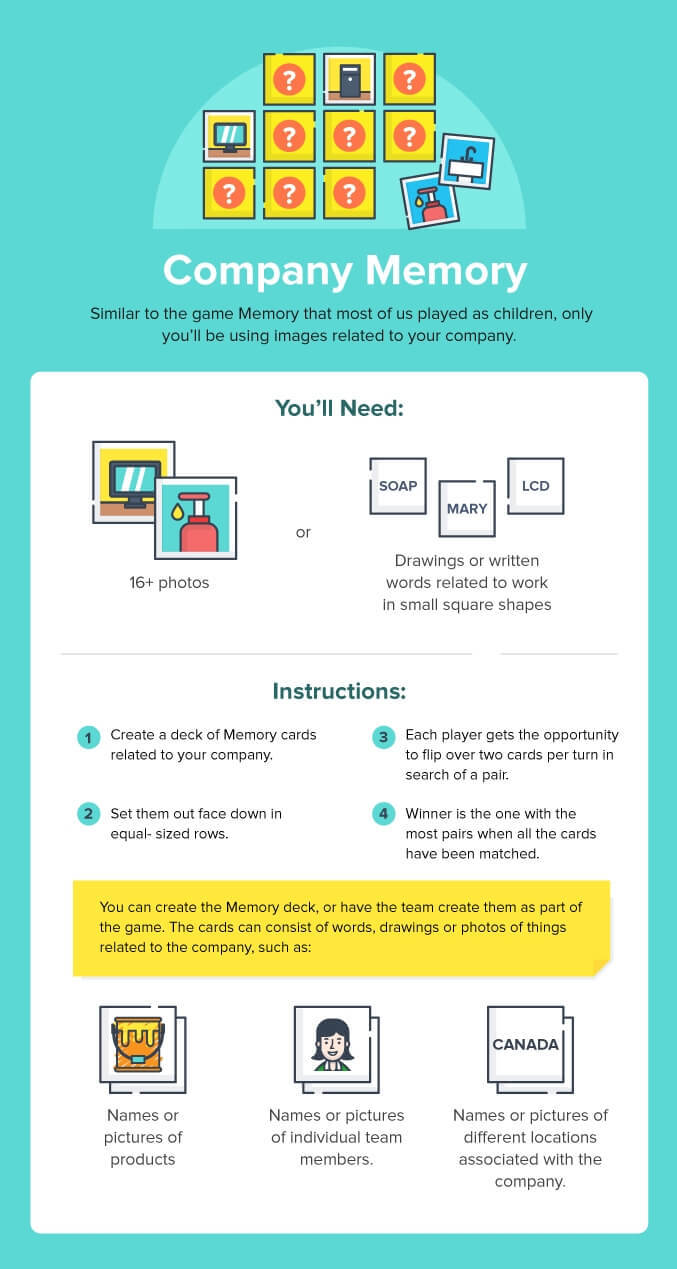
35. Penny For Your Thoughts.
Team members randomly select pennies, then share a significant event that happened to them during the year stamped on the penny.
Instructions:
- Gather one penny for each team member, making sure that the dates on the pennies cover a reasonable time span for people to remember (10-15 years is probably good).
- Randomly pass a coin out to each team member and give them a few minutes to come up with an important memory (or memories) from that year.
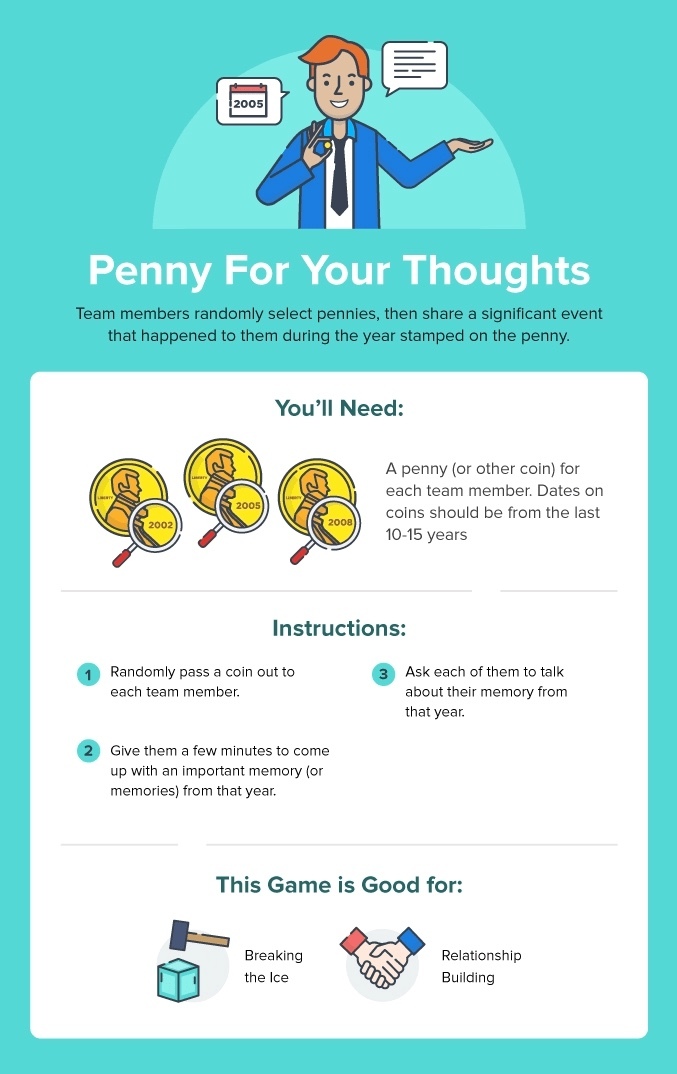
36. A Shrinking Vessel.
Team members have to figure out how to fit themselves into an ever-shrinking space.
Instructions:
- Start by marking off a space on the floor with a rope, blanket, or tape.
- Have your team stand in that space, and shrink the space regularly, say every two minutes.
- The team will have to think fast and work together to keep everyone within the shrinking boundaries.
Tip: After the first round, you may want to have team members talk about strategies for doing better, then try again and see how much they can improve.
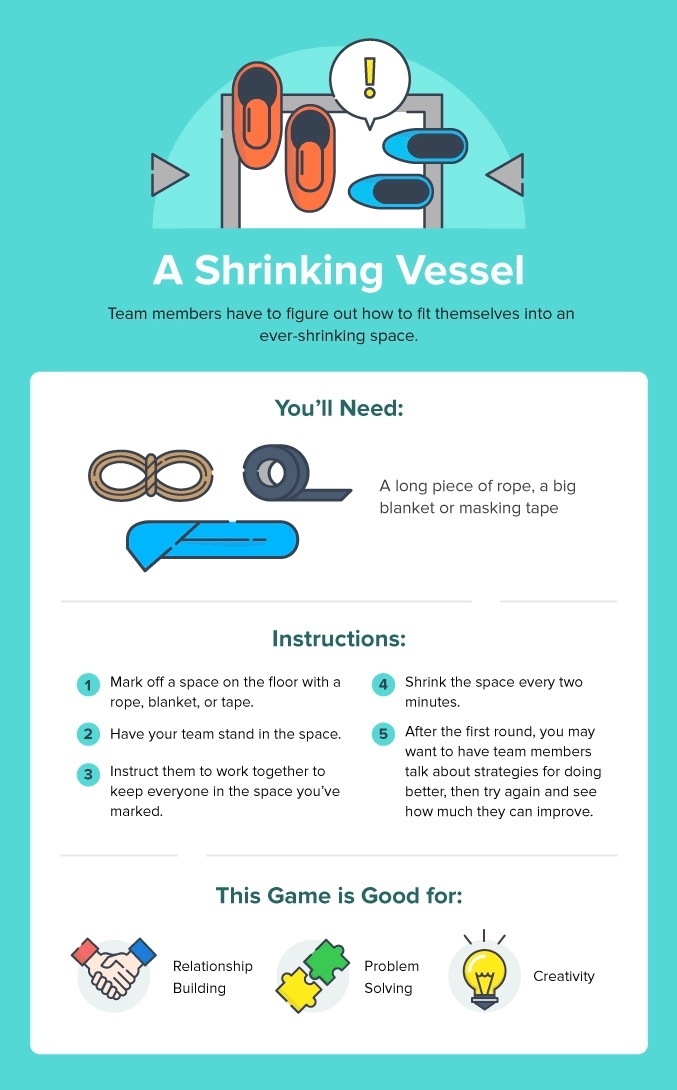
37. Sneak a Peek Game.
Team members use blocks to build a replica of a structure that the person leading the activity has created.
Instructions:
- Start with a couple of sets of building blocks for children, some Legos, or a couple of Jenga sets.
- Build a small structure that is hidden from your team members.
- Divide your team into small groups and have them choose one person from each team to come up and spend 10 seconds looking at what you built.
- Have them go back to their group and give directions for recreating the structure.
- After one minute they can send a different team member to inspect the structure for 10 seconds, and then work for another minute.
- Continue in this way until one (or all) of the teams have recreated the structure.
